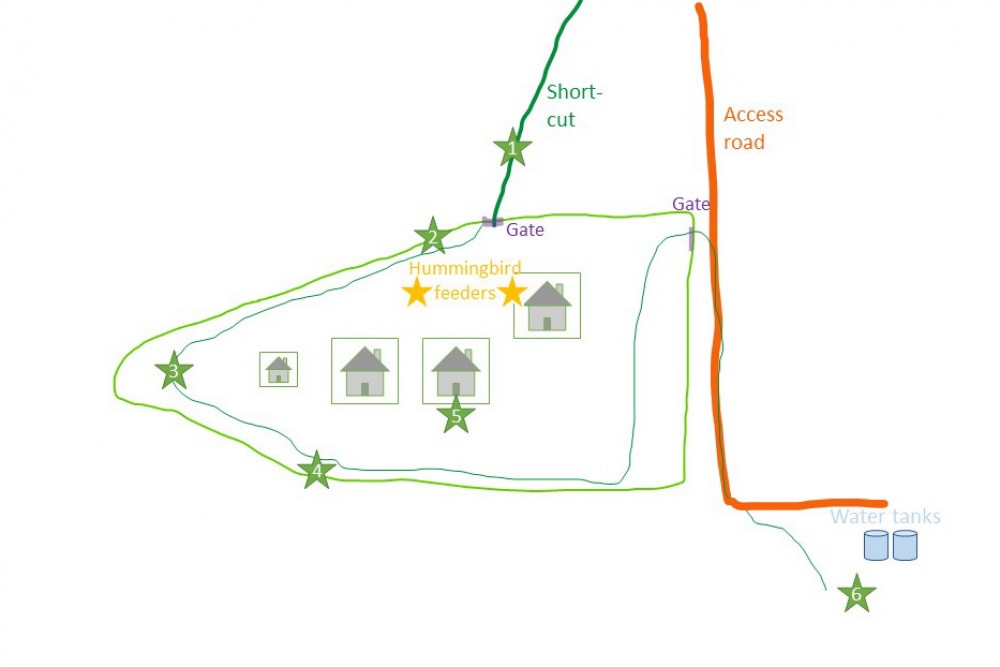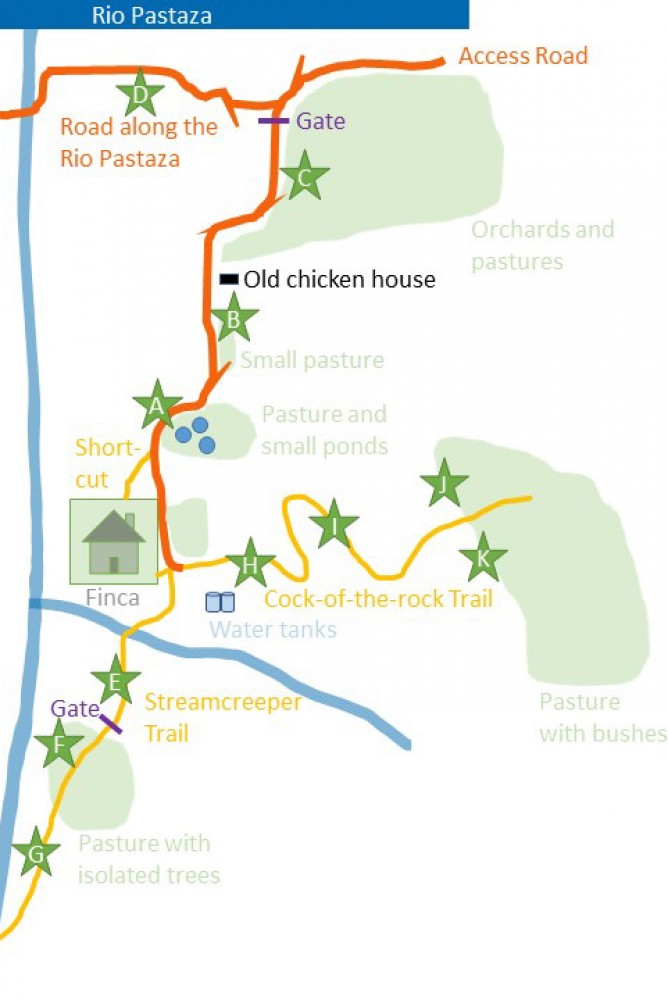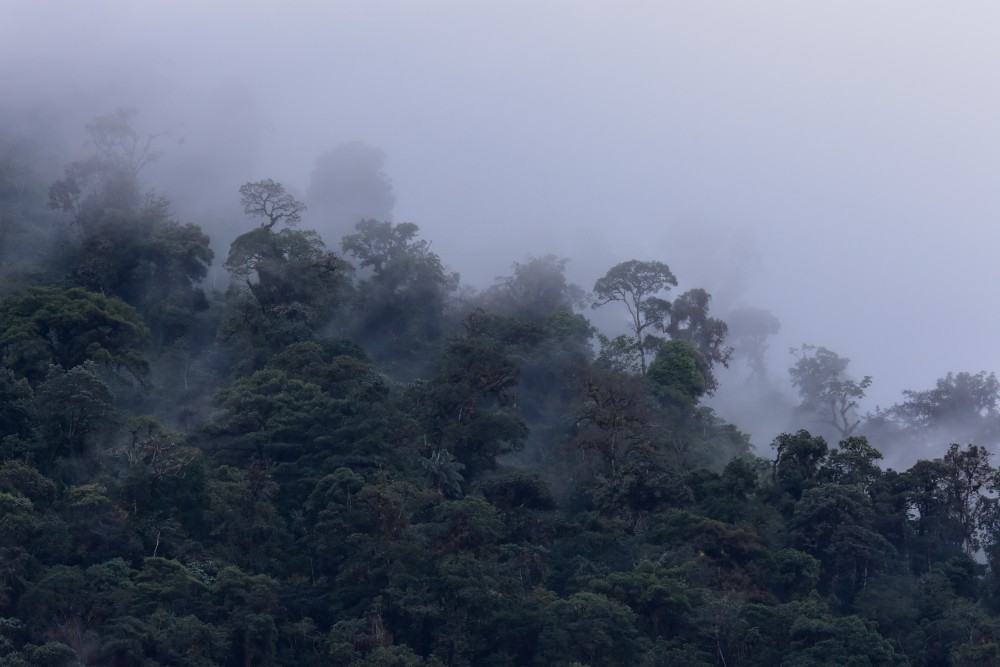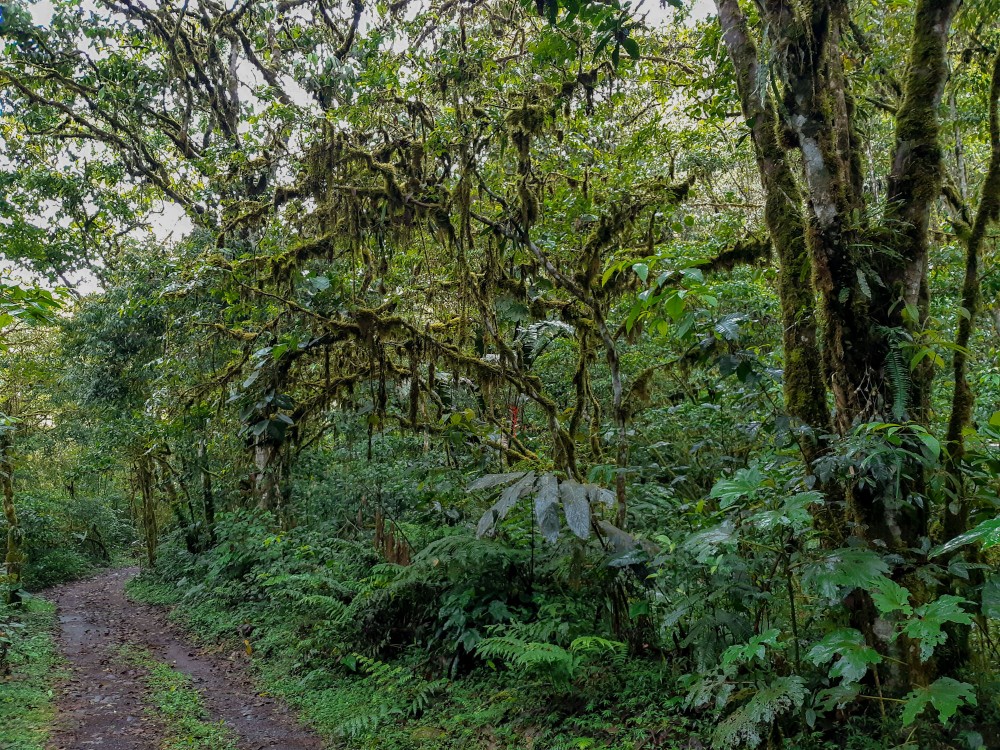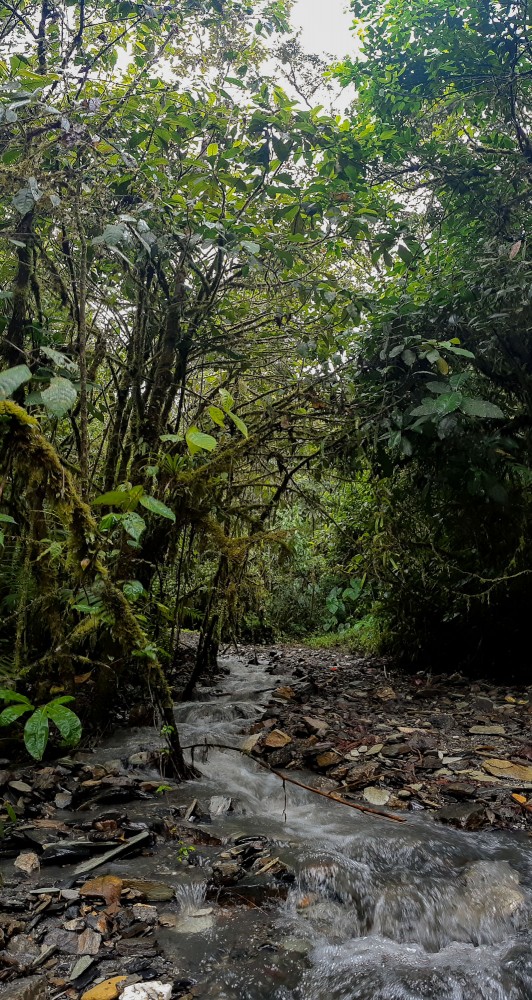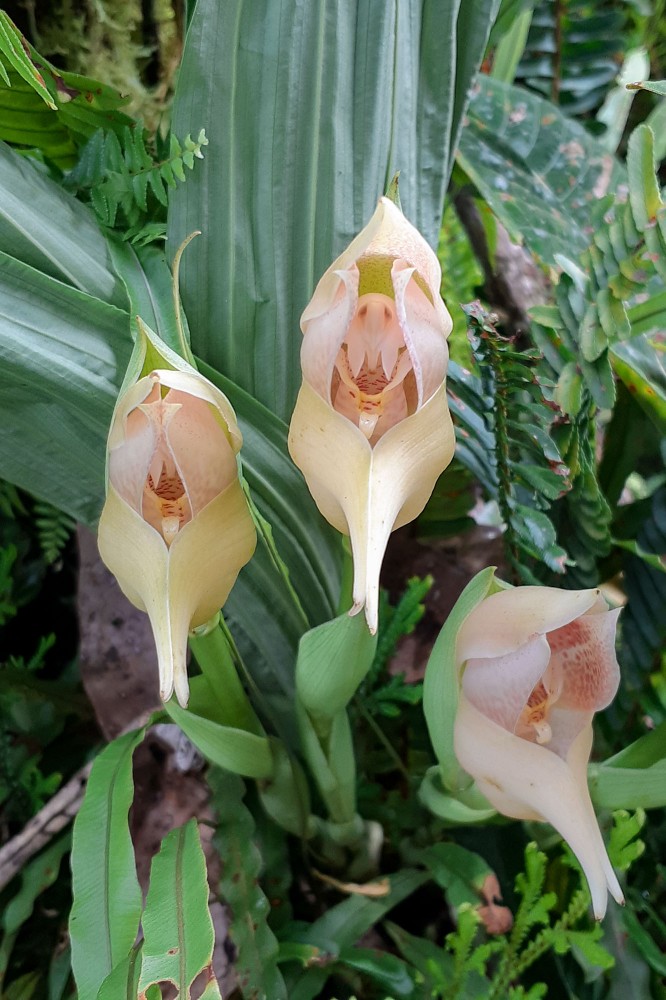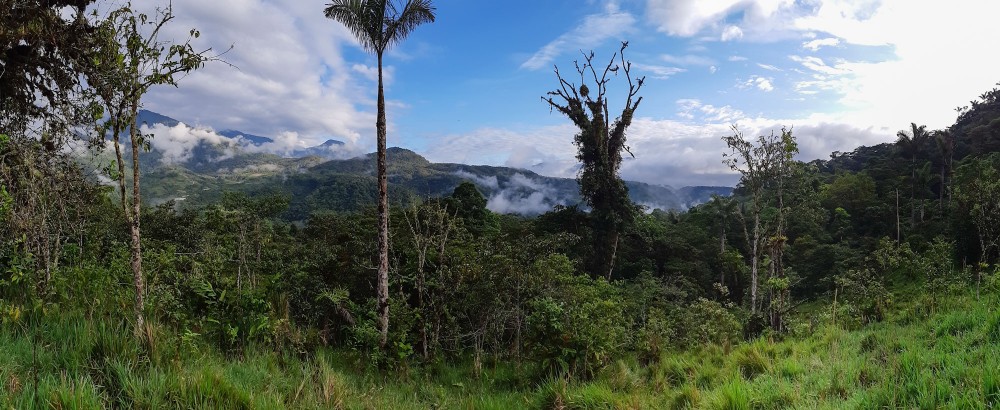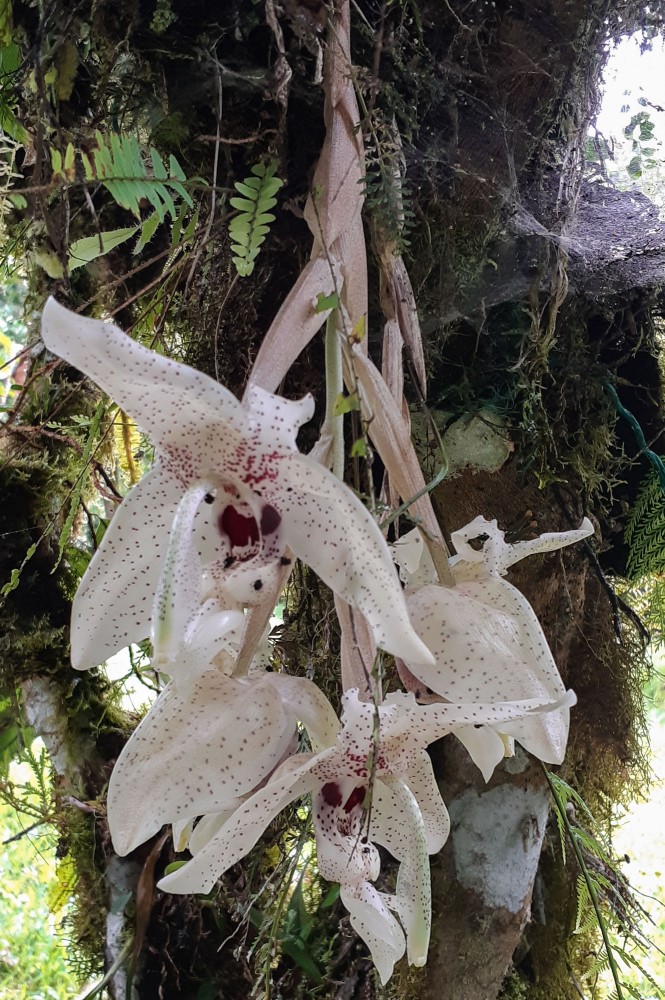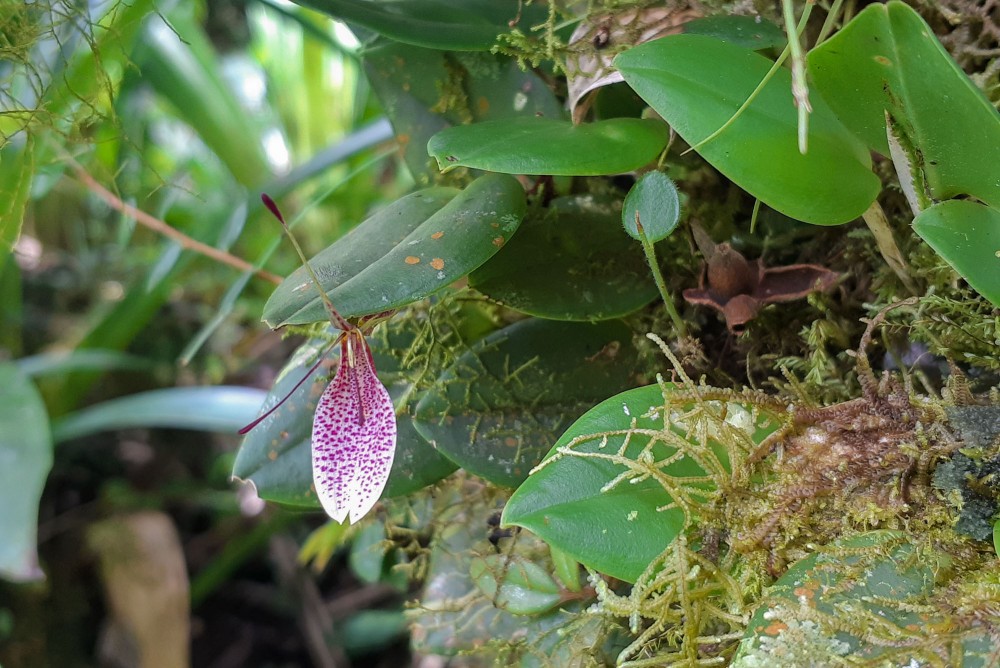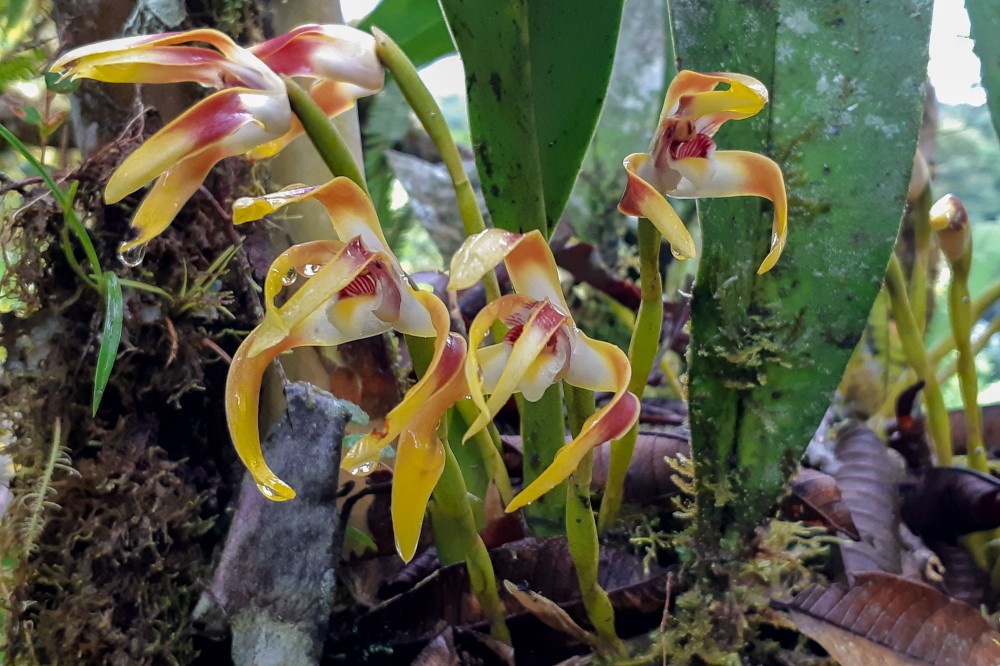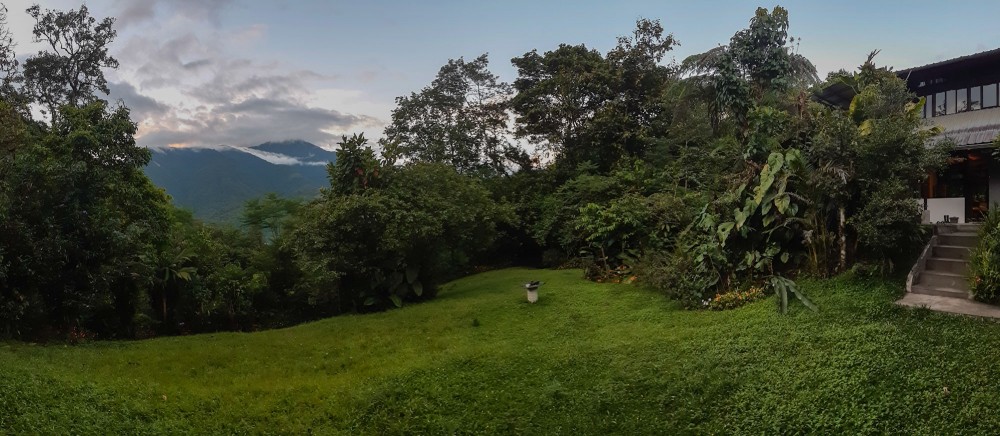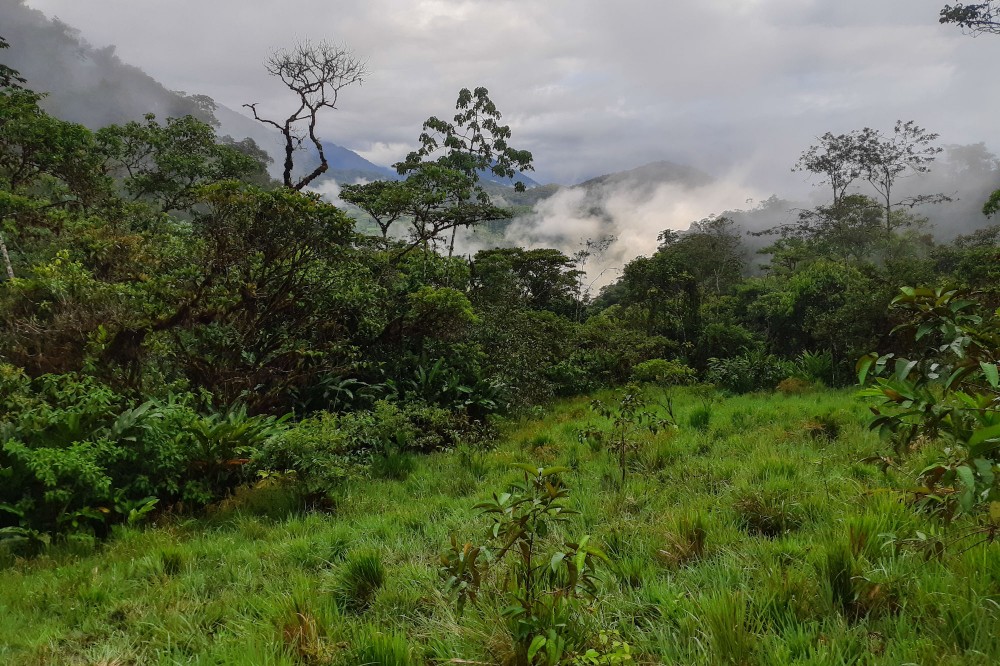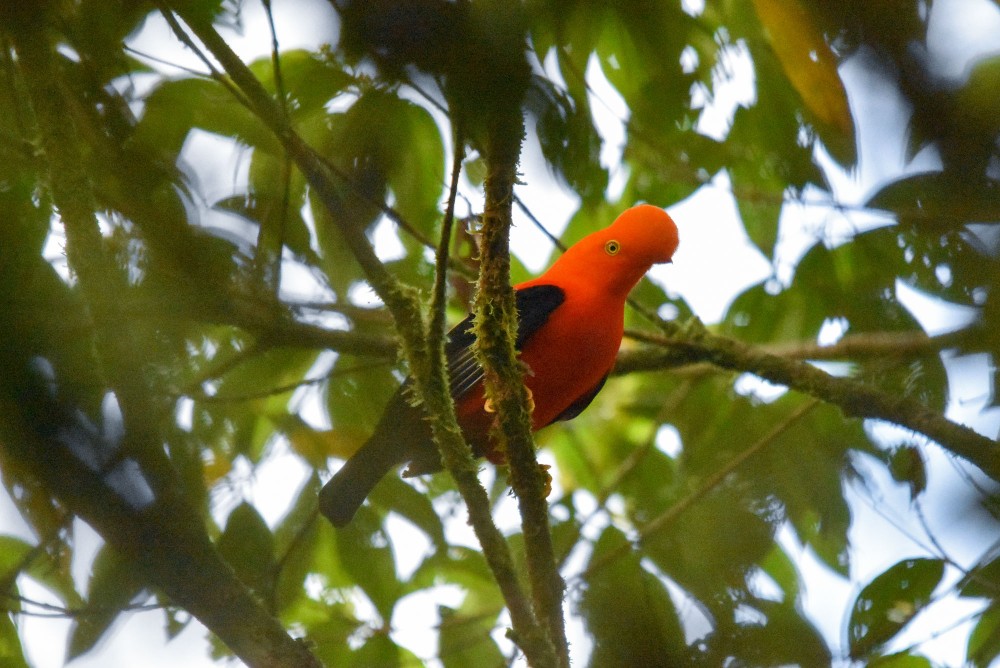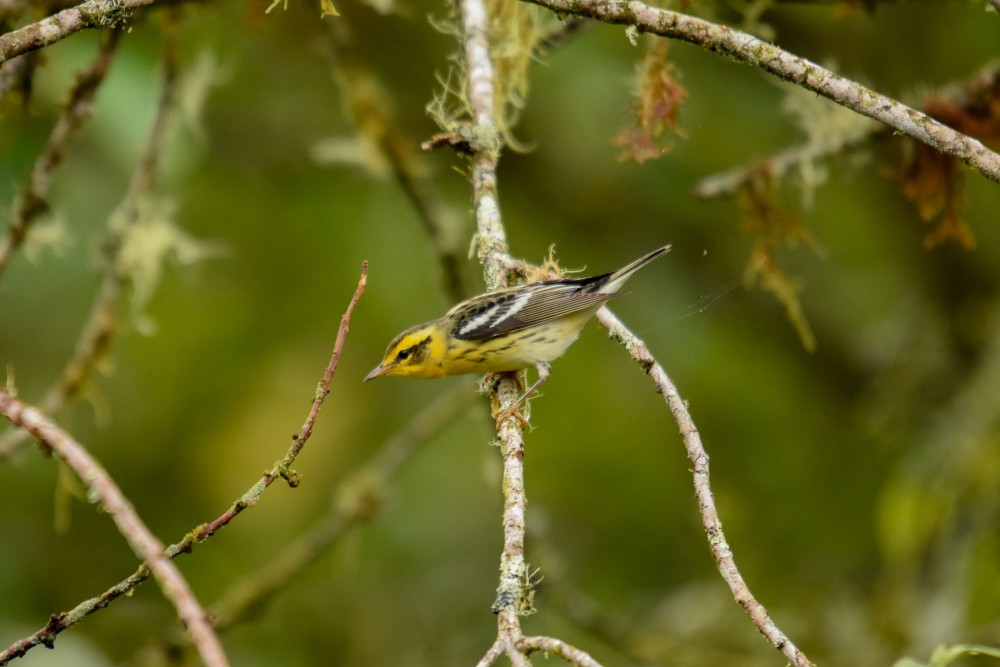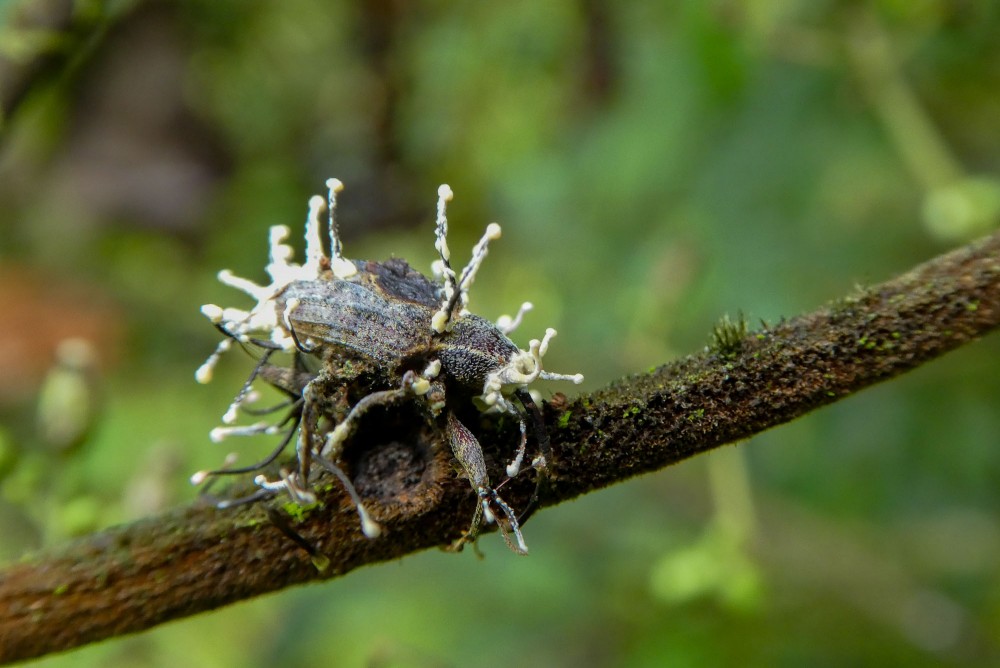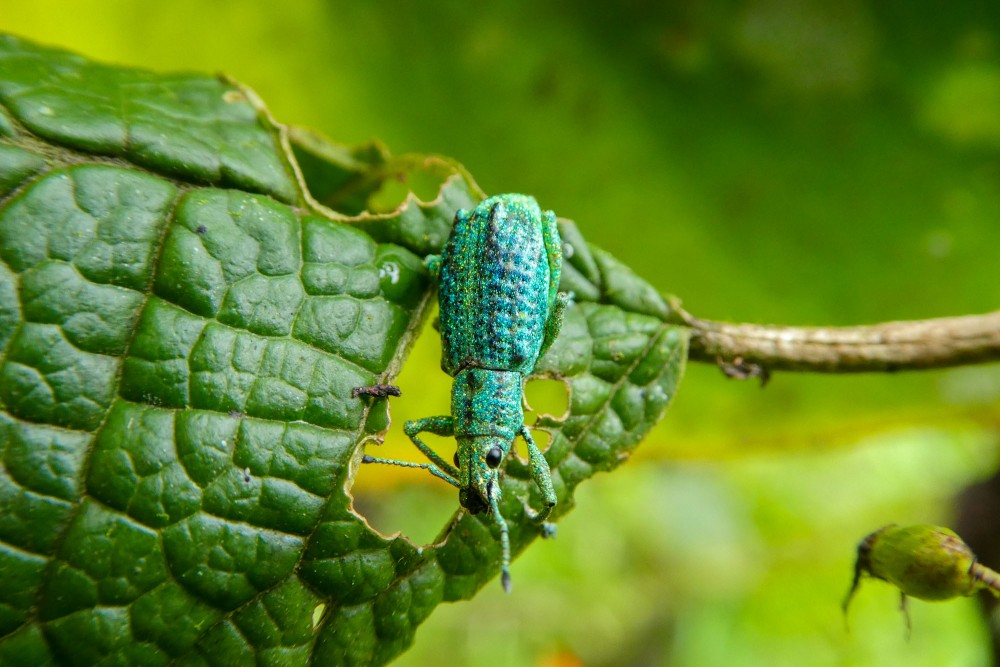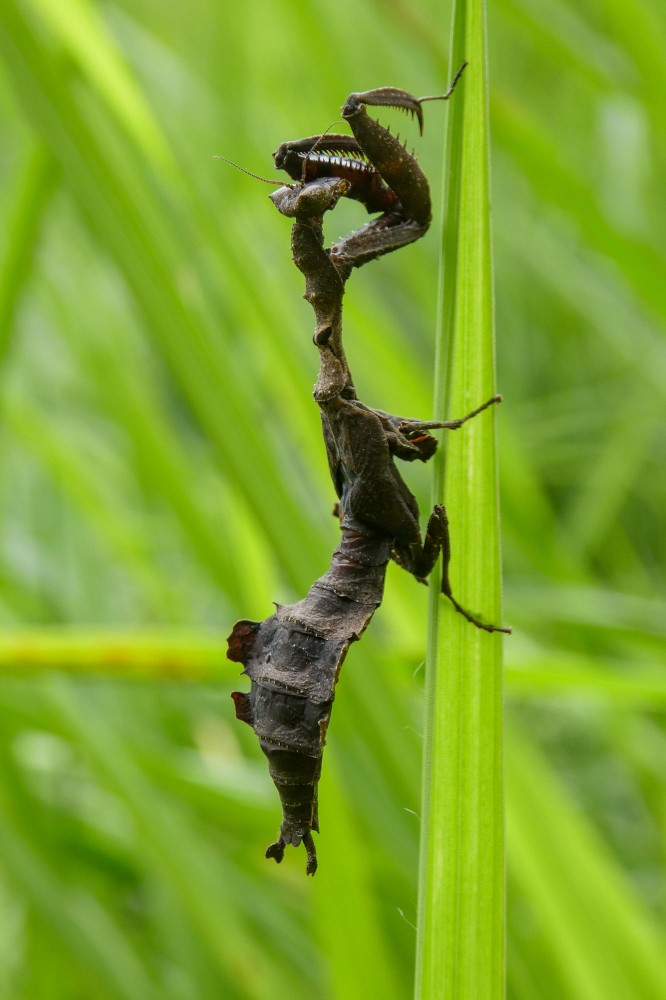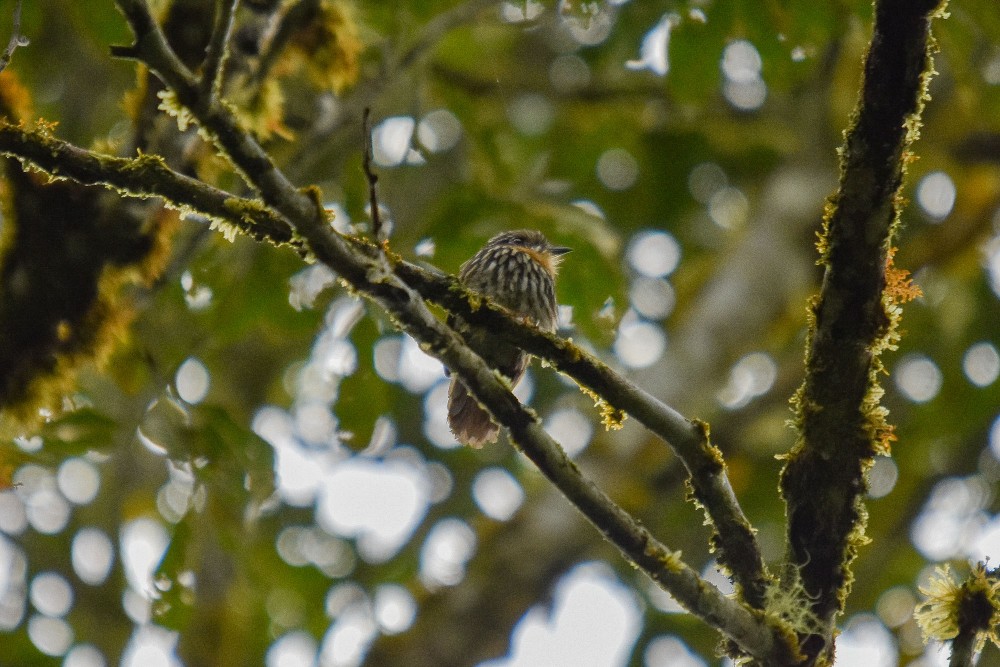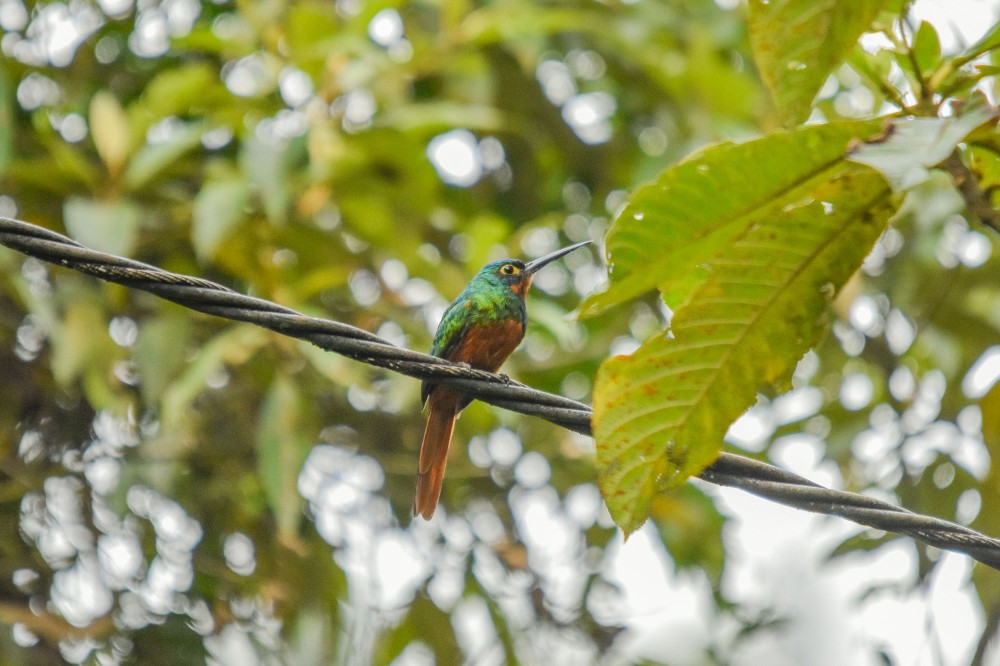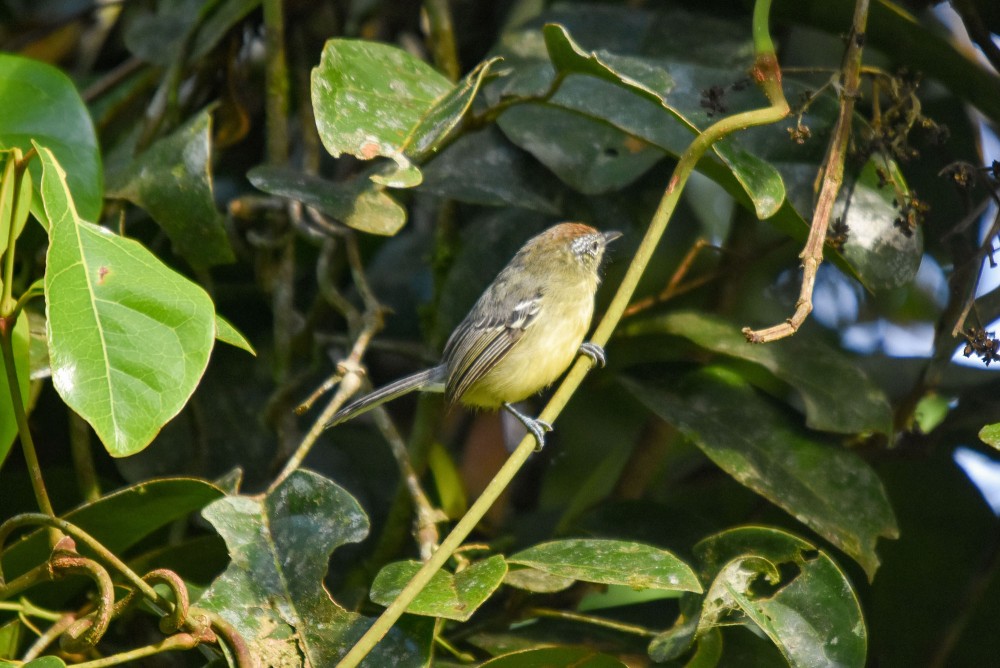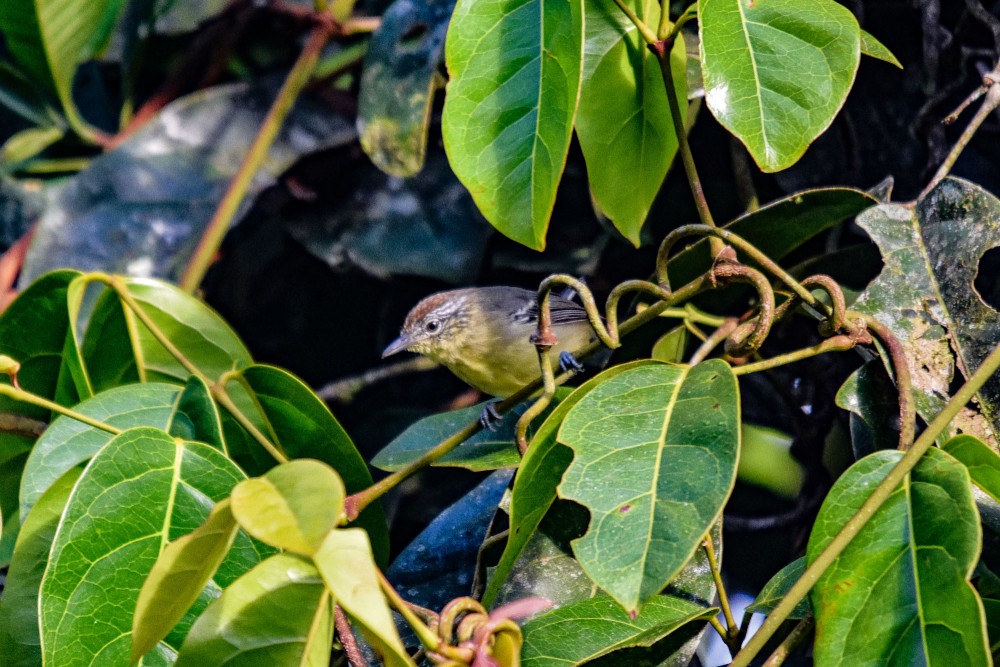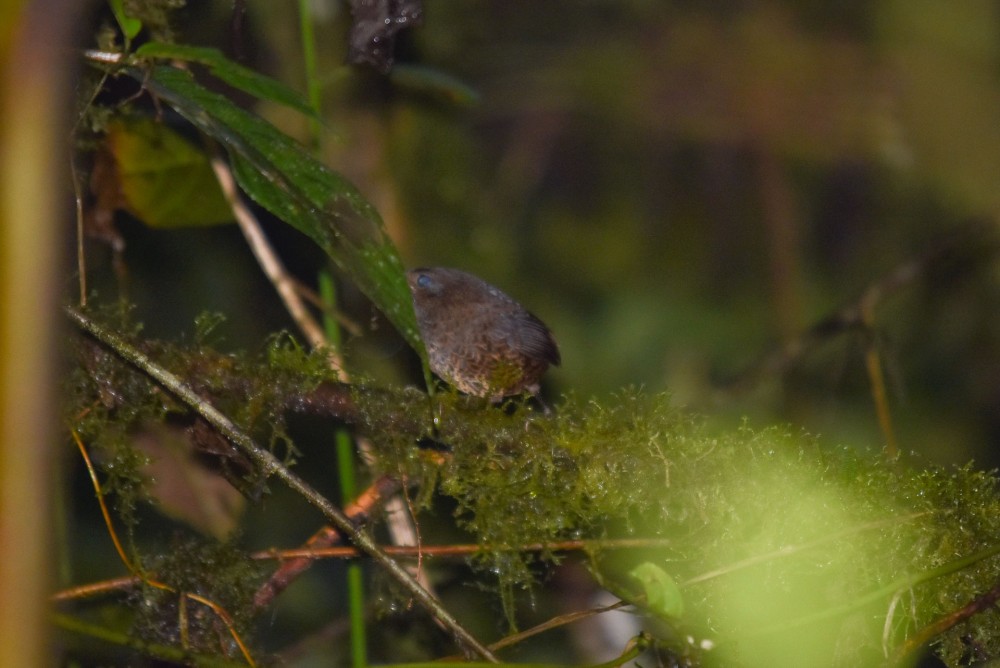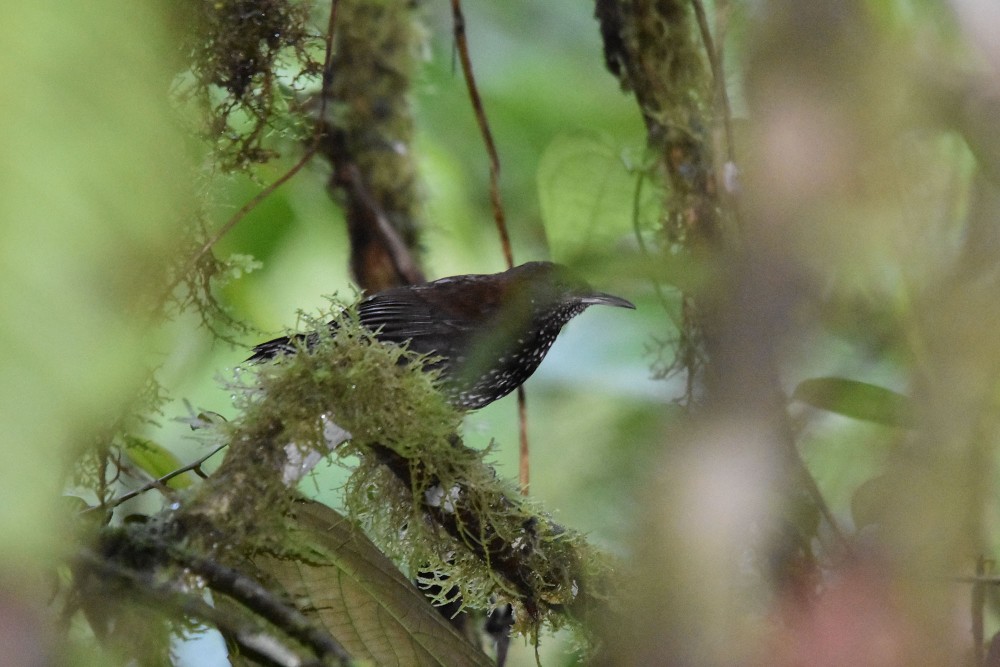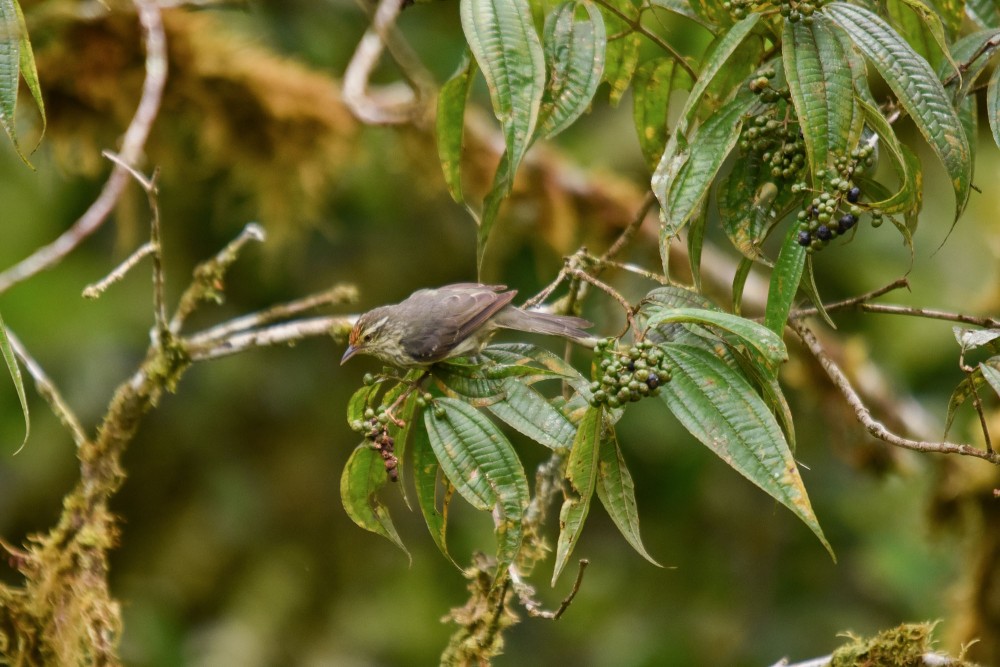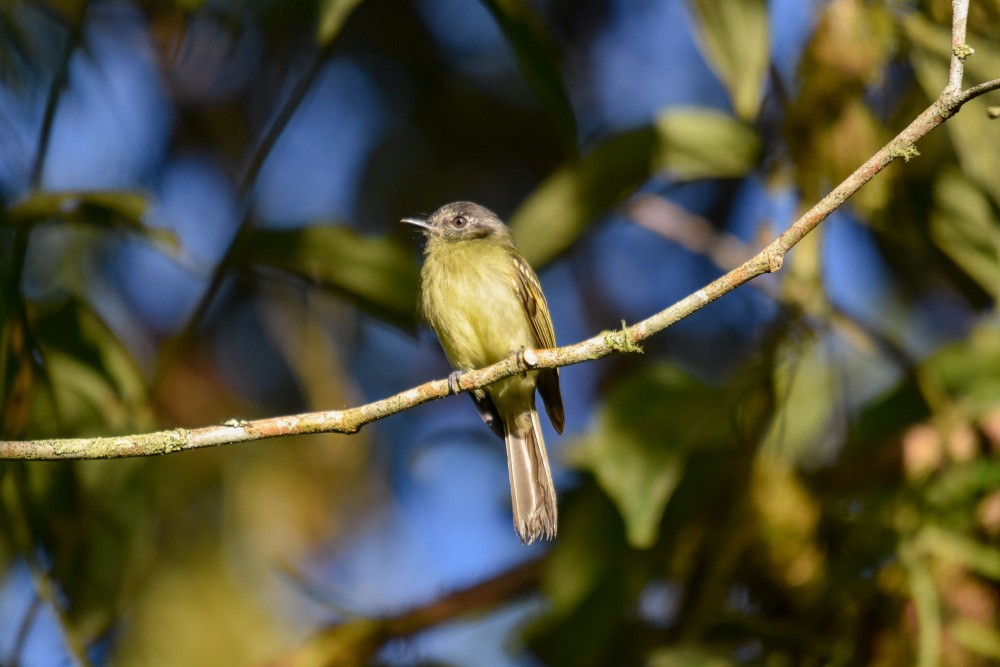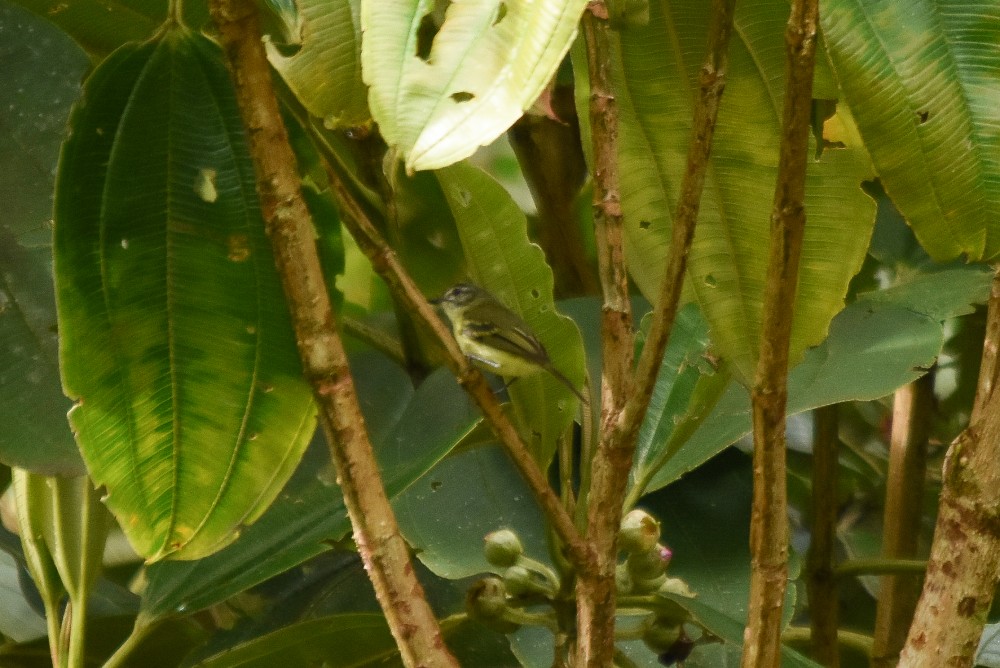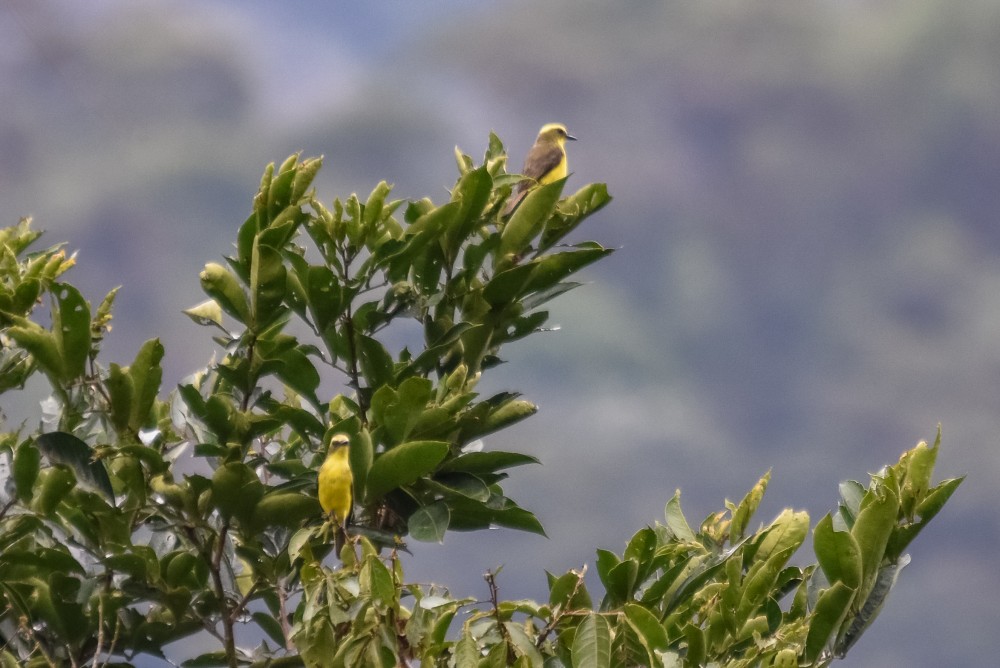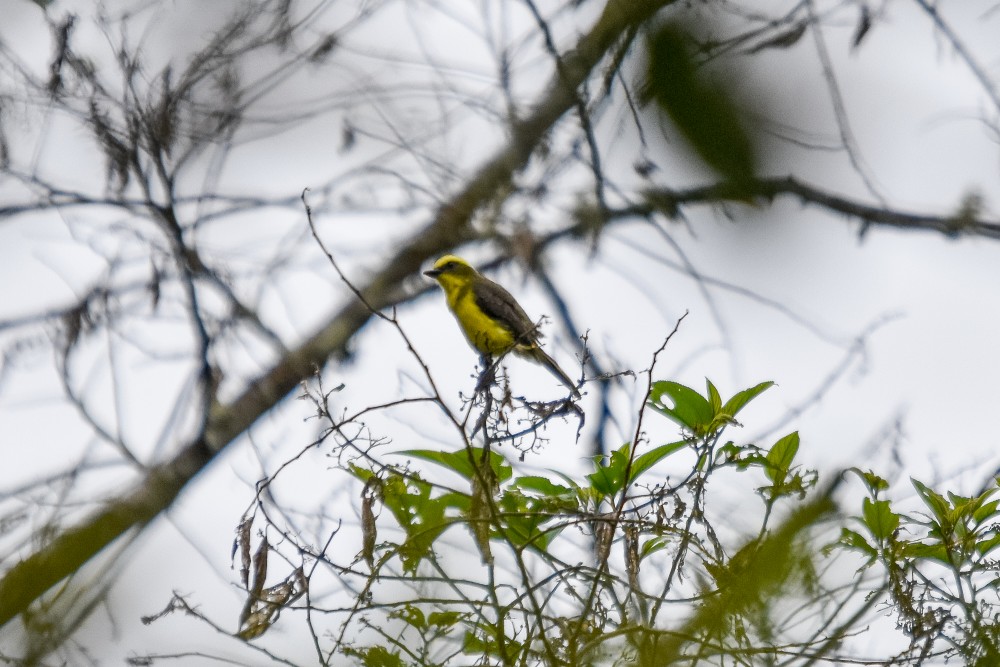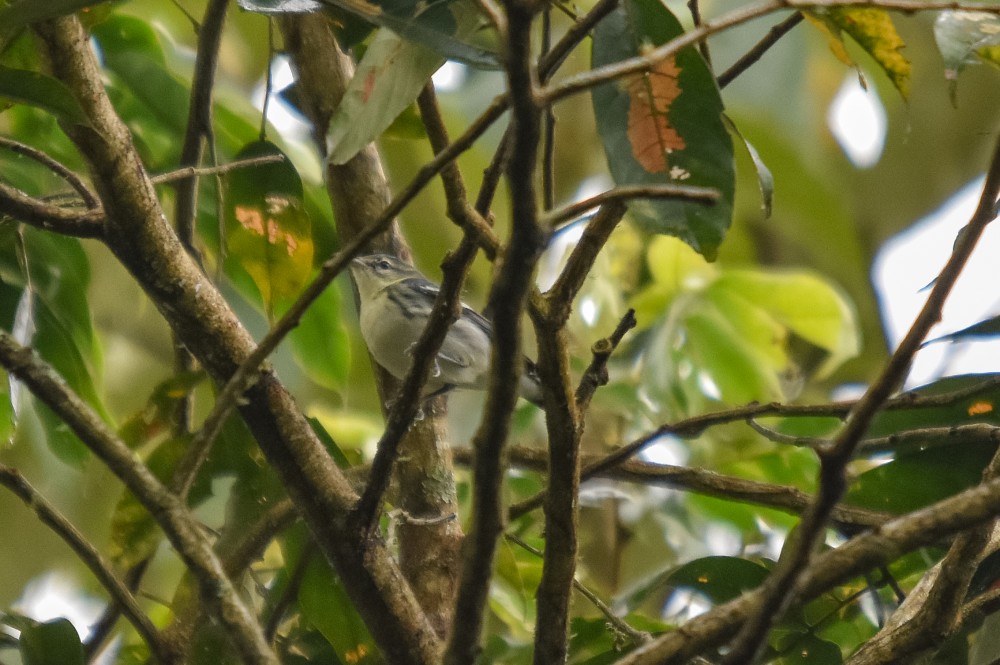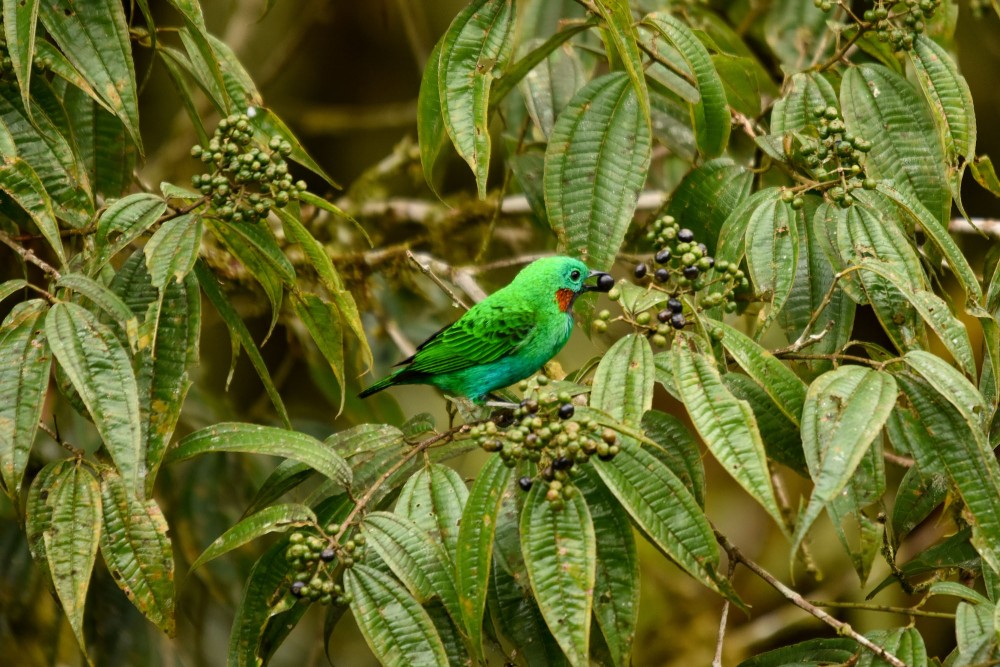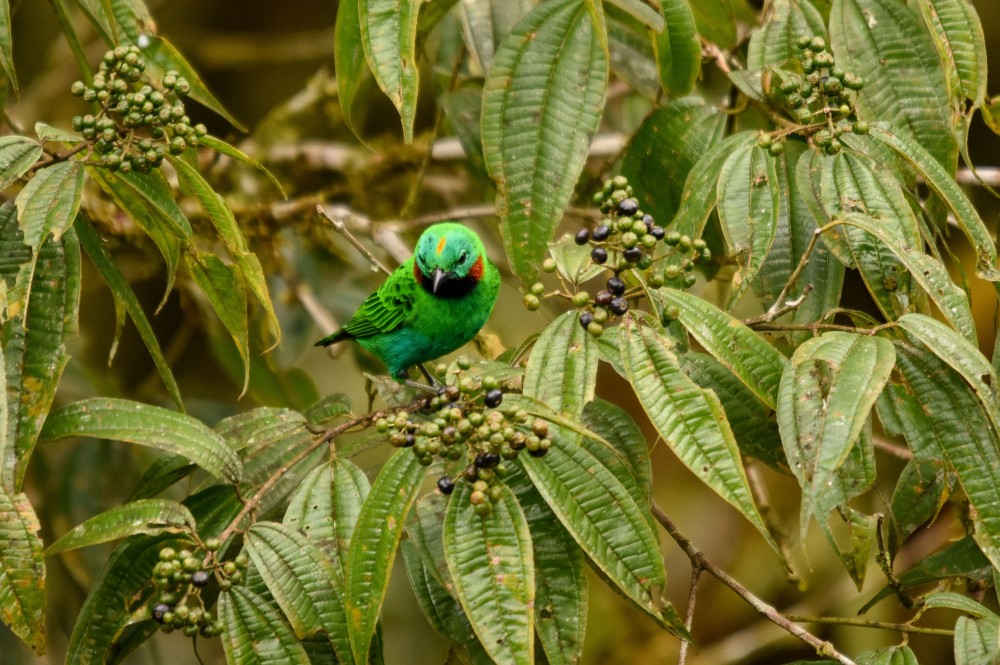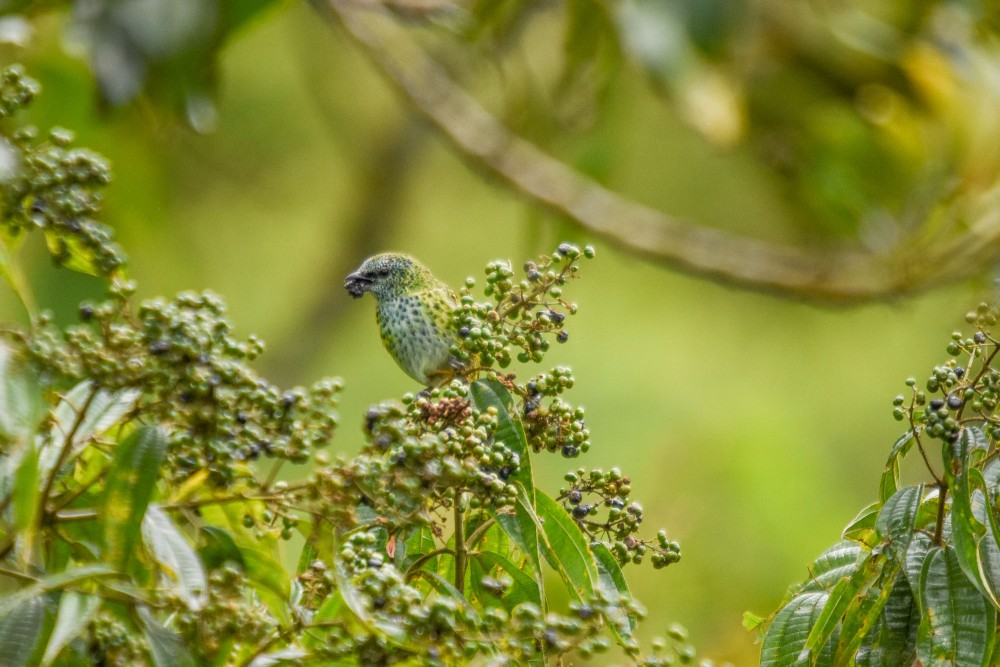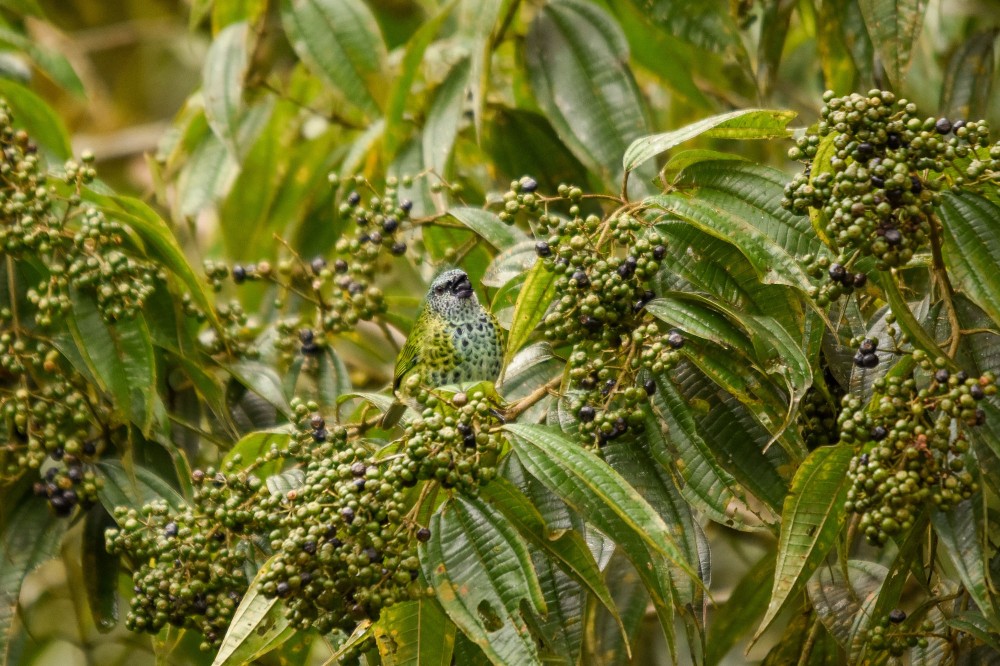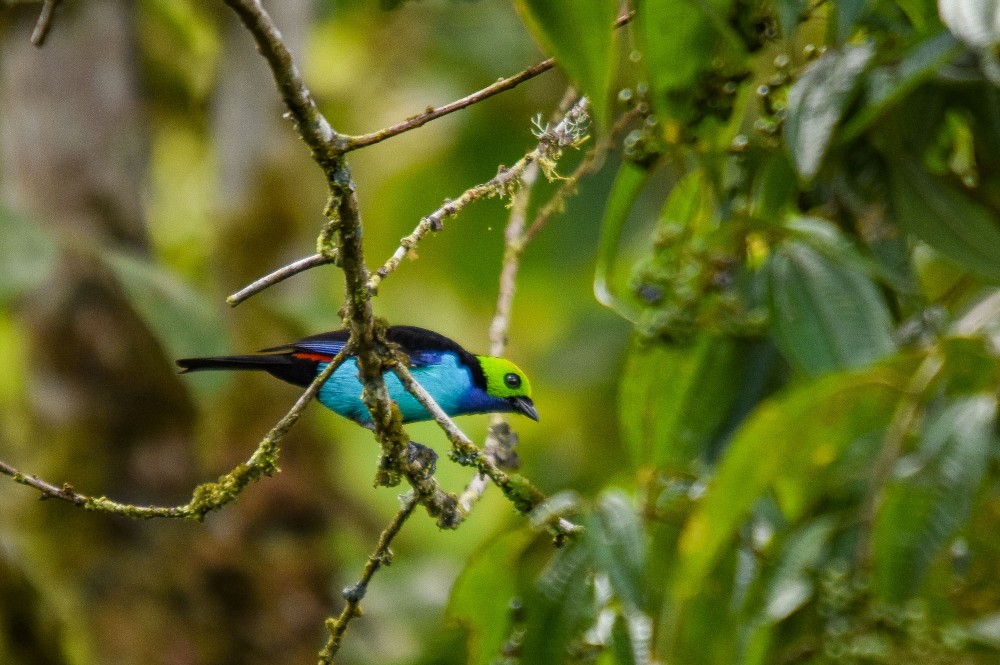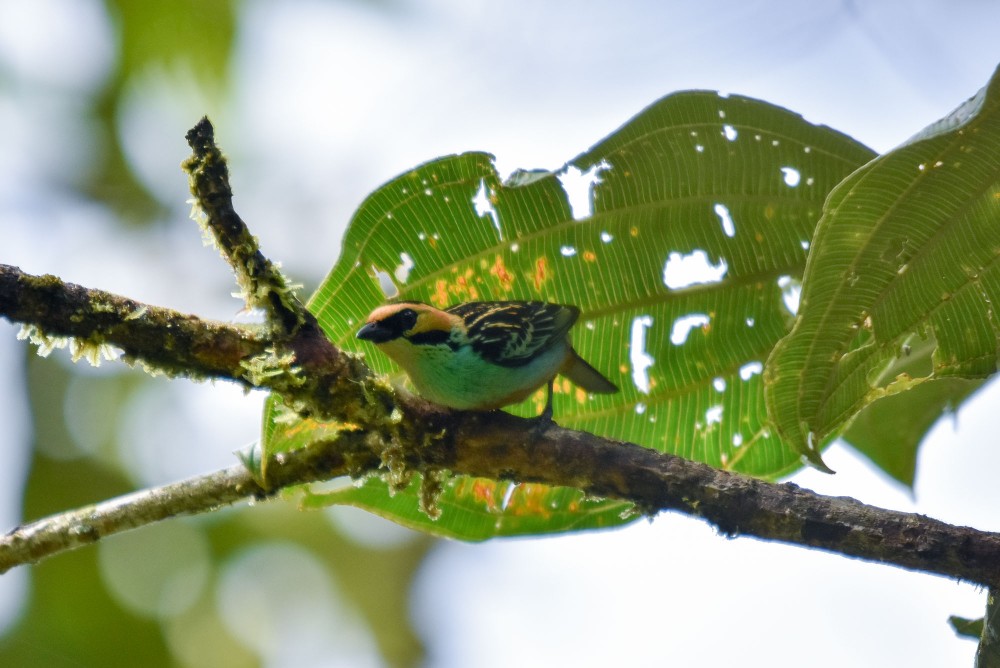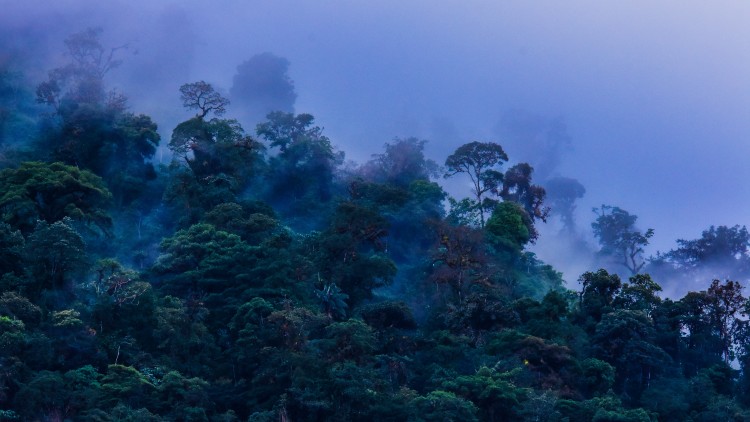
Finca Palmonte, Ecuador
09 December 2019 – 27 December 2019
We did three weeks of volunteering in the Finca Palmonte. We mainly watched the birds early in the morning and a bit in the afternoon.
Visited Sites
Finca Palmonte
Finca Palmonte is really a hidden gem! It is a 80 ha private nature reserve with a finca managed by a Swiss-Ecuadorian couple, located on the eastern slope of the Andes in the Ecological Corridor Llanganates-Sangay. The reserve consists mainly of cloud forests, but you can find also some more open grazing areas with some bushes and isolated trees. Even if a majority of the forest directly around the Finca is secondary, it is nonetheless magnificent (trees full of mosses and epiphytes of all kinds) and with an incredible biodiversity. The garden alone is completely fascinating with almost 100 species of orchids.
For the moment only the garden and the Access Road are easily accessible. The other trails are not yet signposted and clear, but you don't have to go very far to see many interesting species.
Some species such as Rufous-breasted Antthrush (Formicarius rufipectus), Blackish Antbird (Cercomacroides nigrescens), Red-headed Barbet (Eubucco bourcierii) or Ash-browed Spinetail (Cranioleuca curtata) are omnipresent in the forests around Finca. The same with Andean Cock-of-the-Rock (Rupicola peruvianus), for which the reserve even holds a lek. Lafresnaye's Piculet (Picumnus lafresnayi), Buff-fronted Foliage-gleaner (Philydor rufum), Eastern Ornate Flycatcher (Myiotriccus phoenicurus) or Fulvous-breasted Flatbill (Rhynchocyclus fulvipectus) are also regularly encountered.
In addition to the species observed during our stay, the owners photographed in the reserve several interesting species such as Black-and-chestnut Eagle (Spizaetus isidori), Black Solitary Hawk (Buteogallus solitarius), Lyre-tailed Nightjar (Uropsalis lyra), Deep-blue Flowerpiercer (Diglossa glauca) and White-capped Tanager (Sericossypha albocristata).
Site map - [letters in brackets refer to the map]
Access Road
The best is to reach the Access Road via the old mule track down of the Finca (Shortcut; see "Garden map"). One of the first area of interest is on the curve with the pastures with the small ponds on your right (A). Sometimes kingfishers or Fasciated Tiger-heron (Tigrisoma fasciatum) could be observed around the water. This open area with some isolated trees (as well as the other open areas just above and below) are good for the Lemon-browed Flycatcher (Conopias cinchoneti) or Dark-breasted Spinetail (Synallaxis albigularis). All the woodlands along the left side of the road are good for mixed-flocks, especially at the level of the first curve. A few tens of meters further, where the forest on the right comes closer to the road (after the second curve), is a nice spot for mixed-flocks as well. There, I heard once a Plain-backed Antpitta (Grallaria haplonota) in the wooded slope on the right. The area with lots of bamboos just before the old chicken house (B) is very interesting. There, Short-billed Bush-tanager (Chlorospingus parvirostris) is present and I encountered once an Amazonian Woodhaunter (Automolus subulatus) and a couple of Coppery-chested Jacamar (Galbula pastazae). Lower down, the terrain is flatter with lemon orchards and grassy areas with small bushes (C). In the last stretch of road right before the gate you have a good view of the bushy and grassy area. In addition to the common species of these habitats, I observed also Dusky Spinetail (Synallaxis moesta), Bran-colored Flycatcher (Myiophobus fasciatus), Yellow-bellied Tanager (Tangara xanthogastra) and Chestnut-bellied Seed-finch (Sporophila angolensis). When you cross the gate, you can go down to the left to a flatter forest on the river bank (D). This forest is really beautiful and holds many interesting species such as Short-billed Bush-tanager (Chlorospingus parvirostris) or Fulvous-breasted Flatbill (Rhynchocyclus fulvipectus). I also heard a Scaled Antpitta (Grallaria guatimalensis) at the end of the descent.
Streamcreeper Trail
The trail that go down south of the Finca is a little bit less interesting than the other surrounding places. However it seems really good for the Streamcreeper (Lochmias nematura). This species can be encountered in the flooded undergrowth espacially just after crossing the first creek (E) in the early morning. If you continue, you will arrive in a pasture where you have a good clearance to watch the regular mixed-flocks (F). When you continue after this open area in the forest along the river (G), you pass again in good habitat for the Streamcreeper (Lochmias nematura).
Cock-of-the-rock Trail
This trail is the continuation of the Access Road that go east of the Finca. The start of the forest, around the small swampy area (H), is good for the mixed-flocks. I regularly saw Fulvous-breasted Flatbill (Rhynchocyclus fulvipectus) there. At dawn, I heard regularly Scaled Antpitta (Grallaria guatimalensis), Long-tailed Tapaculo (Scytalopus micropterus) and I saw Rufous-bellied Nighthawk (Lurocalis rufiventris) and Green-fronted Lancebill (Doryfera ludovicae) from this same spot. The way up in the forest is good for the insectivore mixed-flocks, especially between the second and the third curve (I). I observed also once two Black-streaked Puffbirds (Malacoptila fulvogularis) at the second curve. The forest here, as well as most forested areas around the Finca holds many Rufous-breasted Antthrush (Formicarius rufipectus). When you continue up, you arrive in the pasture on the top of the ridge. The big bording trees and the bushy area on the left side (J) hosted important concentrations of migratory birds such as Cerulean Warbler (Setophaga cerulea), many Blackburnian Warbler (Setophaga fusca) and Swainson's Thrush (Catharus swainsoni). The area on the right of the end of the forest (K) is just as well worth it. From the pasture, I heard once a Wattled Guan (Aburria aburri) in the forest above.
Garden Map - [number in brackets refer to the map]
The garden alone is worth the detour! You can encounter many nice species. Some common ones are Golden-eared Tanager (Tangara chrysotis), Orange-eared Tanager (Chlorochrysa calliparaea), Spotted Tanager (Tangara punctata) and Paradise Tanager (Tangara chilensis). Some less frequently observed were Red-billed Parrot (Pionus sordidus), Equatorial Greytail (Xenerpestes singularis), Golden-collared Honeycreeper (Iridophanes pulcherrimus) or Olivaceous Siskin (Spinus olivaceus).
Around the Finca, there are two feeders for the hummingbirds that are visited almost exclusively by Violet-fronted Brilliant (Heliodoxa leadbeateri) and Booted Racket-tail (Ocreatus underwoodii). Sometimes White-tailed Hillstar (Urochroa leucura) can be seen in the garden and more rarely White-tipped Sickelbill (Eutoxeres aquila).
The garden is also home to many wintering birds coming from the Northern Hemisphera; mainly Swainson's Thrush (Catharus swainsoni), Blackburnian Warbler (Setophaga fusca), Canada Warbler (Cardellina canadensis), Cerulean Warbler (Setophaga cerulea) and Summer Tanager, but also Olive-sided Flycatcher (Contopus cooperi), Western Wood-Pewee (Contopus sordidulus) or Scarlet Tanager (Piranga olivacea).
The old mule track (Shortcut) down of the Finca (1) is probably one of the best place around the garden to observe the birds. Not only do mixed-flocks often pass by, but the clearance to observe them is very favourable, especially from the bench. Interesting species observed there included Yellow-breasted Antwren (Herpsilochmus axillaris), Rufous-rumped Antwren (Euchrepomis callinota), Plumbeous-crowned Tyrannulet (Phyllomyias plumbeiceps), Ecuadorian Tyrannulet (Phylloscartes gualaquizae), Black-and-white Becard (Pachyramphus albogriseus) and Olivaceous Greenlet (Hylophilus olivaceus). North American species are also common around. From the garden, there is an opening in the vegetation that also allows to see this wooded area (2). The nearby biggest tree is always worth looking at the birds on it. I observed there Plumbeous-crowned Tyrannulet (Phyllomyias plumbeiceps), Ecuadorian Tyrannulet (Phylloscartes gualaquizae), Lemon-browed Flycatcher (Conopias cinchoneti), Grey-mantled Wren (Odontorchilus branickii) or White-winged Tanager (Piranga leucoptera). The west end of the garden (3) is a good place to watch the mixed-flocks in the canopy. In the southern part of the garden below the dinning room, a small "window" in the vegetation with a basic bench (4) also allows to observe the mixed-flocks on the other side of the creek. Near the oldest house, fruit trees (5) were attracting many tanagers and co. easily observable from the second floor of this house.
Behind the water tanks (6), there is a good viewpoint and large trees covered with epiphytes that often attract mixed-flocks with many furnariidae like sometimes Equatorial Greytail (Xenerpestes singularis).
Target species
-
 Wattled Guan
Aburria aburri
Wattled Guan
Aburria aburri
Apparently rare: seen once and heard once
-
 White-tipped Sicklebill
Eutoxeres aquila
White-tipped Sicklebill
Eutoxeres aquila
Apparently rare
-
 Green-backed Hillstar
Urochroa leucura
Green-backed Hillstar
Urochroa leucura
Seen irregularly around the Finca and in the nearby undergrowth
-
 Band-bellied Owl
Pulsatrix melanota
Band-bellied Owl
Pulsatrix melanota
Heard once from the Finca
-
 Coppery-chested Jacamar
Galbula pastazae
Coppery-chested Jacamar
Galbula pastazae
Encountered irregularly along the Access road
-
 Black-streaked Puffbird
Malacoptila fulvogularis
Black-streaked Puffbird
Malacoptila fulvogularis
Seen once
-
 Plain-backed Antpitta
Grallaria haplonota
Plain-backed Antpitta
Grallaria haplonota
Heard once
-
 Sharp-tailed Streamcreeper
Lochmias nematura
Sharp-tailed Streamcreeper
Lochmias nematura
Probably relatively common in the swampy undergrowth South of the Finca between the two rivers
-
 Equatorial Graytail
Xenerpestes singularis
Equatorial Graytail
Xenerpestes singularis
Seen irregularly around the Finca
-
 Andean Cock-of-the-rock
Rupicola peruvianus
Andean Cock-of-the-rock
Rupicola peruvianus
Common
-
 Ecuadorian Tyrannulet
Phylloscartes gualaquizae
Ecuadorian Tyrannulet
Phylloscartes gualaquizae
Seen irregularly around the Finca
-
 Plumbeous-crowned Tyrannulet
Phyllomyias plumbeiceps
Plumbeous-crowned Tyrannulet
Phyllomyias plumbeiceps
Seen twice around the Finca
-
 Lemon-browed Flycatcher
Conopias cinchoneti
Lemon-browed Flycatcher
Conopias cinchoneti
Uncommon around the Finca and the Access road
-
 Gray-mantled Wren
Odontorchilus branickii
Gray-mantled Wren
Odontorchilus branickii
Seen once around the Finca
-
 Short-billed Chlorospingus
Chlorospingus parvirostris
Short-billed Chlorospingus
Chlorospingus parvirostris
Uncommon in the lower part of the Access road
-
 Cerulean Warbler
Setophaga cerulea
Cerulean Warbler
Setophaga cerulea
Surprisingly common (espacially around the Finca and at the ridge)
-
 White-winged Tanager
Piranga leucoptera
White-winged Tanager
Piranga leucoptera
Seen twice around the Finca
-
 Golden-collared Honeycreeper
Iridophanes pulcherrimus
Golden-collared Honeycreeper
Iridophanes pulcherrimus
Rather rare
-
 Orange-eared Tanager
Chlorochrysa calliparaea
Orange-eared Tanager
Chlorochrysa calliparaea
Common
-
 Golden-eared Tanager
Tangara chrysotis
Golden-eared Tanager
Tangara chrysotis
Common
How to get there
Finca Palmonte is located near the road Baños-Puyo (23 km from Baños), Area San Francisco-La Palmera.
To access the reserve, it is essential to contact before coming Arlette and Alexandre, either via e-mail or via WhatsApp (+593 (0)99 717 94 68). You cannot reach directly the reserve by public transport or with your own car but they will organize your trip from Baños (Baños de Agua Santa), the nearest city or elswhere.
Facilities & accommodation
The Finca has 5 rooms and can host up to 8 people. There is electricity and hot water but no wi-fi. They can provide meals (the food is varied and very good, espacially the amazing breakfasts ;-)).
Local guides
No local guide known (Arlette and Alex know mostly about orchids and insects, but they are interested in all wildlife).
Other wildlife observed
In addition to numerous insects, the nature reserve is home to several spectacular mammals. Even though the easiest to observe are the Amazon Darf Squirrel (Microsciurus flaviventer) and Red-tailed Squirrel (Notosciurus granatensis), the mammals list includes Spectacled Bear (Tremarctos ornatus), Puma (Puma concolor), Ocelot (Leopardus pardalis), Jaguarundi (Herpailurus yagouaroundi), Mountain tapir (Tapirus pinchaque), Mountain Paca (Cuniculus taczanowskii) and Olinguito (Bassaricyon neblina).
Species List
-
 Speckled Chachalaca
Ortalis guttata
details
sounds
Speckled Chachalaca
Ortalis guttata
details
sounds
-
Finca Palmonte
2019-12-13 2 ind. 2019-12-14 1 ind. 2019-12-15 1 ind. 2019-12-19 1 ind. 2019-12-25 2 ind. 2019-12-26 9 ind. Min. 2019-12-27 2 ind.
-
-
 Wattled Guan
Aburria aburri
details
sounds
Wattled Guan
Aburria aburri
details
sounds
-
Finca Palmonte
2019-12-16 1 ind. 2019-12-18 1 ind. (heard only)
-
-
 Sickle-winged Guan
Chamaepetes goudotii
details
sounds
Sickle-winged Guan
Chamaepetes goudotii
details
sounds
-
Finca Palmonte
2019-12-16 2 ind. 2019-12-18 2 ind.
-
-
 Plumbeous Pigeon
Patagioenas plumbea
details
sounds
Plumbeous Pigeon
Patagioenas plumbea
details
sounds
-
Finca Palmonte (heard only)
2019-12-17 1 ind. 2019-12-20 1 ind.
-
-
 Ruddy Pigeon
Patagioenas subvinacea
details
sounds
Ruddy Pigeon
Patagioenas subvinacea
details
sounds
-
Finca Palmonte
2019-12-10 1 ind. 2019-12-12 1 ind. 2019-12-15 1 ind. 2019-12-16 1 ind. 2019-12-18 2 ind.
-
-
 Gray-fronted Dove
Leptotila rufaxilla
details
sounds
Gray-fronted Dove
Leptotila rufaxilla
details
sounds
-
Finca Palmonte
2019-12-24 1 ind. 2019-12-26 1 ind.
-
-
 White-throated Quail-Dove
Zentrygon frenata
details
sounds
White-throated Quail-Dove
Zentrygon frenata
details
sounds
-
Finca Palmonte
2019-12-16 1 ind.
-
-
 Smooth-billed Ani
Crotophaga ani
details
sounds
Smooth-billed Ani
Crotophaga ani
details
sounds
-
Finca Palmonte
2019-12-20 2 ind.
-
-
 Squirrel Cuckoo
Piaya cayana
details
sounds
Squirrel Cuckoo
Piaya cayana
details
sounds
-
Finca Palmonte
Relatively common
-
-
 Rufous-bellied Nighthawk
Lurocalis rufiventris
details
sounds
Rufous-bellied Nighthawk
Lurocalis rufiventris
details
sounds
-
Finca Palmonte
2019-12-24 1 ind. Hunting at dawn 2019-12-25 2 ind. 2019-12-26 1 ind.
-
-
 Chestnut-collared Swift
Streptoprocne rutila
details
sounds
Chestnut-collared Swift
Streptoprocne rutila
details
sounds
-
Finca Palmonte
Relatively common
-
-
 White-collared Swift
Streptoprocne zonaris
details
sounds
White-collared Swift
Streptoprocne zonaris
details
sounds
-
Finca Palmonte
Relatively common
-
-
 White-tipped Swift
Aeronautes montivagus
details
sounds
White-tipped Swift
Aeronautes montivagus
details
sounds
-
Finca Palmonte
2019-12-20 1 ind.
-
-
 White-tipped Sicklebill
Eutoxeres aquila
details
sounds
White-tipped Sicklebill
Eutoxeres aquila
details
sounds
-
Finca Palmonte
2019-12-25 1 ind.
-
-
 Green Hermit
Phaethornis guy
details
sounds
Green Hermit
Phaethornis guy
details
sounds
-
Finca Palmonte
2019-12-24 1 ind.
-
-
 Tawny-bellied Hermit
Phaethornis syrmatophorus
details
sounds
Tawny-bellied Hermit
Phaethornis syrmatophorus
details
sounds
-
Finca Palmonte
2019-12-15 1 ind. 2019-12-17 1 ind.
-
-
 Gray-chinned Hermit
Phaethornis griseogularis
details
sounds
Gray-chinned Hermit
Phaethornis griseogularis
details
sounds
-
Finca Palmonte
2019-12-10 1 ind. 2019-12-14 1 ind.
-
-
 Green-fronted Lancebill
Doryfera ludovicae
details
sounds
Green-fronted Lancebill
Doryfera ludovicae
details
sounds
-
Finca Palmonte
2019-12-10 2 ind. 2019-12-20 1 ind. 2019-12-23 1 ind.
-
-
 Long-tailed Sylph
Aglaiocercus kingii
details
sounds
Long-tailed Sylph
Aglaiocercus kingii
details
sounds
-
Finca Palmonte
2019-12-26 1 ind.
-
-
 Peruvian Racket-tail
Ocreatus peruanus
details
sounds
Peruvian Racket-tail
Ocreatus peruanus
details
sounds
-
Finca Palmonte
Relatively common around the Finca (up to 3 different birds), also regularly seen elsewhere
-
-
 Green-backed Hillstar
Urochroa leucura
details
sounds
Green-backed Hillstar
Urochroa leucura
details
sounds
-
Finca Palmonte
2019-12-15 2 ind. 2019-12-16 1 ind. 2019-12-24 1 ind.
-
-
 Violet-fronted Brilliant
Heliodoxa leadbeateri
details
sounds
Violet-fronted Brilliant
Heliodoxa leadbeateri
details
sounds
-
Finca Palmonte
Common around the Finca (up to 4 different birds observed)
-
-
 Glittering-throated Emerald
Chionomesa fimbriata
details
sounds
Glittering-throated Emerald
Chionomesa fimbriata
details
sounds
-
Finca Palmonte
2019-12-26 1 ind.
-
-
 Black Vulture
Coragyps atratus
details
sounds
Relatively common
Black Vulture
Coragyps atratus
details
sounds
Relatively common-
Finca Palmonte
-
-
 Turkey Vulture
Cathartes aura
details
sounds
Turkey Vulture
Cathartes aura
details
sounds
-
Finca Palmonte
Common at this site.
-
-
 Sharp-shinned Hawk
Accipiter striatus
details
sounds
Sharp-shinned Hawk
Accipiter striatus
details
sounds
-
Finca Palmonte
2019-12-09 1 ind.
-
-
 Roadside Hawk
Rupornis magnirostris
details
sounds
Roadside Hawk
Rupornis magnirostris
details
sounds
-
Finca Palmonte
2019-12-10 1 ind. 2019-12-17 1 ind. 2019-12-19 1 ind. 2019-12-20 1 ind. 2019-12-23 1 ind. 2019-12-26 1 ind.
-
-
 White-rumped Hawk
Parabuteo leucorrhous
details
sounds
White-rumped Hawk
Parabuteo leucorrhous
details
sounds
-
Finca Palmonte
2019-12-09 1 ind.
-
-
 Broad-winged Hawk
Buteo platypterus
details
sounds
Broad-winged Hawk
Buteo platypterus
details
sounds
-
Finca Palmonte
2019-12-25 1 ind.
-
-
 Band-bellied Owl
Pulsatrix melanota
details
sounds
Band-bellied Owl
Pulsatrix melanota
details
sounds
-
Finca Palmonte (heard only)
2019-12-27 1 ind.
-
-
 Andean Motmot
Momotus aequatorialis
details
sounds
Andean Motmot
Momotus aequatorialis
details
sounds
-
Finca Palmonte (heard only)
2019-12-12 1 ind. 2019-12-13 1 ind.
-
-
 Black-streaked Puffbird
Malacoptila fulvogularis
details
sounds
Black-streaked Puffbird
Malacoptila fulvogularis
details
sounds
-
 Coppery-chested Jacamar
Galbula pastazae
details
sounds
Coppery-chested Jacamar
Galbula pastazae
details
sounds
-
 Red-headed Barbet
Eubucco bourcierii
details
sounds
Red-headed Barbet
Eubucco bourcierii
details
sounds
-
Finca Palmonte
Relatively common
-
-
 Lafresnaye's Piculet
Picumnus lafresnayi
details
sounds
Lafresnaye's Piculet
Picumnus lafresnayi
details
sounds
-
Finca Palmonte
2019-12-14 1 ind. 2019-12-18 1 ind. 2019-12-19 2 ind. 2019-12-24 1 ind. 2019-12-25 2 ind.
-
-
 Smoky-brown Woodpecker
Dryobates fumigatus
details
sounds
Smoky-brown Woodpecker
Dryobates fumigatus
details
sounds
-
Finca Palmonte
2019-12-15 1 ind.
-
-
 Lineated Woodpecker
Dryocopus lineatus
details
sounds
Lineated Woodpecker
Dryocopus lineatus
details
sounds
-
Finca Palmonte
2019-12-13 1 ind. 2019-12-16 1 ind.
-
-
 Golden-olive Woodpecker
Colaptes rubiginosus
details
sounds
Golden-olive Woodpecker
Colaptes rubiginosus
details
sounds
-
Finca Palmonte
2019-12-11 2 ind. 2019-12-14 1 ind. 2019-12-19 1 ind.
-
-
 Black Caracara
Daptrius ater
details
sounds
Black Caracara
Daptrius ater
details
sounds
-
Finca Palmonte
2019-12-26 2 ind.
-
-
 Red-billed Parrot
Pionus sordidus
details
sounds
Red-billed Parrot
Pionus sordidus
details
sounds
-
Finca Palmonte
2019-12-18 4 ind. 2019-12-24 ≥ 3 ind. Min.
-
-
 White-eyed Parakeet
Psittacara leucophthalmus
details
sounds
White-eyed Parakeet
Psittacara leucophthalmus
details
sounds
-
Finca Palmonte
Encountered only once.
-
-
 Rufous-rumped Antwren
Euchrepomis callinota
details
sounds
Rufous-rumped Antwren
Euchrepomis callinota
details
sounds
-
Finca Palmonte
2019-12-19 1 ind.
-
-
 Lined Antshrike
Thamnophilus tenuepunctatus
details
sounds
Lined Antshrike
Thamnophilus tenuepunctatus
details
sounds
-
Finca Palmonte (heard only)
2019-12-16 1 ind.
-
-
 Plain Antvireo
Dysithamnus mentalis
details
sounds
Plain Antvireo
Dysithamnus mentalis
details
sounds
-
Finca Palmonte
2019-12-15 2 ind.
-
-
 Yellow-breasted Antwren
Herpsilochmus axillaris
details
sounds
Yellow-breasted Antwren
Herpsilochmus axillaris
details
sounds
-
 Dot-winged Antwren
Microrhopias quixensis
details
sounds
Dot-winged Antwren
Microrhopias quixensis
details
sounds
-
Finca Palmonte
2019-12-25 1 ind. Male seen well
-
-
 Blackish Antbird
Cercomacroides nigrescens
details
sounds
Blackish Antbird
Cercomacroides nigrescens
details
sounds
-
Finca Palmonte
Common at this site.
-
-
 Scaled Antpitta
Grallaria guatimalensis
details
sounds
Scaled Antpitta
Grallaria guatimalensis
details
sounds
-
Finca Palmonte (heard only)
2019-12-24 1 ind. 2019-12-25 1 ind. 2019-12-26 1 ind. 2019-12-27 1 ind. 2019-12-15 1 ind. 2019-12-16 1 ind.
-
-
 Plain-backed Antpitta
Grallaria haplonota
details
sounds
Plain-backed Antpitta
Grallaria haplonota
details
sounds
-
Finca Palmonte (heard only)
2019-12-20 1 ind.
-
-
 Long-tailed Tapaculo
Scytalopus micropterus
details
sounds
Long-tailed Tapaculo
Scytalopus micropterus
details
sounds
-
 Rufous-breasted Antthrush
Formicarius rufipectus
details
sounds
Rufous-breasted Antthrush
Formicarius rufipectus
details
sounds
-
Finca Palmonte
Relatively common
-
-
 Olivaceous Woodcreeper
Sittasomus griseicapillus
details
sounds
Olivaceous Woodcreeper
Sittasomus griseicapillus
details
sounds
-
Finca Palmonte (heard only)
2019-12-27 1 ind.
-
-
 Plain-brown Woodcreeper
Dendrocincla fuliginosa
details
sounds
Plain-brown Woodcreeper
Dendrocincla fuliginosa
details
sounds
-
Finca Palmonte
2019-12-15 1 ind. 2019-12-16 1 ind.
-
-
 Wedge-billed Woodcreeper
Glyphorynchus spirurus
details
sounds
Wedge-billed Woodcreeper
Glyphorynchus spirurus
details
sounds
-
Finca Palmonte
2019-12-10 1 ind.
-
-
 Olive-backed Woodcreeper
Xiphorhynchus triangularis
details
sounds
Olive-backed Woodcreeper
Xiphorhynchus triangularis
details
sounds
-
Finca Palmonte
Relatively common
-
-
 Streaked Xenops
Xenops rutilans
details
sounds
Streaked Xenops
Xenops rutilans
details
sounds
-
Finca Palmonte
Relatively common
-
-
 Sharp-tailed Streamcreeper
Lochmias nematura
details
sounds
Sharp-tailed Streamcreeper
Lochmias nematura
details
sounds
-
 Montane Foliage-gleaner
Anabacerthia striaticollis
details
sounds
Montane Foliage-gleaner
Anabacerthia striaticollis
details
sounds
-
Finca Palmonte
Common at this site.
-
-
 Buff-fronted Foliage-gleaner
Dendroma rufa
details
sounds
Buff-fronted Foliage-gleaner
Dendroma rufa
details
sounds
-
Finca Palmonte
2019-12-14 2 ind. 2019-12-18 2 ind. 2019-12-20 1 ind. 2019-12-26 2 ind.
-
-
 Eastern Woodhaunter
Automolus subulatus
details
sounds
Eastern Woodhaunter
Automolus subulatus
details
sounds
-
Finca Palmonte
2019-12-26 1 ind.
-
-
 Spotted Barbtail
Premnoplex brunnescens
details
sounds
Spotted Barbtail
Premnoplex brunnescens
details
sounds
-
Finca Palmonte
2019-12-24 2 ind.
-
-
 Equatorial Graytail
Xenerpestes singularis
details
sounds
Equatorial Graytail
Xenerpestes singularis
details
sounds
-
 Ash-browed Spinetail
Cranioleuca curtata
details
sounds
Ash-browed Spinetail
Cranioleuca curtata
details
sounds
-
Finca Palmonte
Relatively common
-
-
 Dusky Spinetail
Synallaxis moesta
details
sounds
Dusky Spinetail
Synallaxis moesta
details
sounds
-
Finca Palmonte
2019-12-20 1 ind.
-
-
 Dark-breasted Spinetail
Synallaxis albigularis
details
sounds
Dark-breasted Spinetail
Synallaxis albigularis
details
sounds
-
Finca Palmonte
2019-12-26 2 ind.
-
-
 Azara's Spinetail
Synallaxis azarae
details
sounds
Azara's Spinetail
Synallaxis azarae
details
sounds
-
Finca Palmonte (heard only)
2019-12-16 1 ind.
-
-
 Golden-winged Manakin
Masius chrysopterus
details
sounds
Golden-winged Manakin
Masius chrysopterus
details
sounds
-
Finca Palmonte (heard only)
2019-12-14 1 ind. 2019-12-16 1 ind.
-
-
 Andean Cock-of-the-rock
Rupicola peruvianus
details
sounds
Andean Cock-of-the-rock
Rupicola peruvianus
details
sounds
-
Finca Palmonte
Common at this site.
-
-
 Masked Tityra
Tityra semifasciata
details
sounds
Masked Tityra
Tityra semifasciata
details
sounds
-
Finca Palmonte
2019-12-12 1 ind. 2019-12-13 2 ind. 2019-12-15 3 ind. 2019-12-18 1 ind. 2019-12-19 2 ind. 2019-12-25 1 ind. 2019-12-26 1 ind. 2019-12-27 1 ind.
-
-
 Black-and-white/Cryptic Becard
Pachyramphus albogriseus/salvini
details
sounds
Black-and-white/Cryptic Becard
Pachyramphus albogriseus/salvini
details
sounds
-
Finca Palmonte
2019-12-10 1 ind. 2019-12-24 3 ind.
-
-
 Streak-necked Flycatcher
Mionectes striaticollis
details
sounds
Streak-necked Flycatcher
Mionectes striaticollis
details
sounds
-
Finca Palmonte
Relatively common
-
-
 Slaty-capped Flycatcher
Leptopogon superciliaris
details
sounds
Slaty-capped Flycatcher
Leptopogon superciliaris
details
sounds
-
 Marble-faced Bristle-Tyrant
Pogonotriccus ophthalmicus
details
sounds
Marble-faced Bristle-Tyrant
Pogonotriccus ophthalmicus
details
sounds
-
Finca Palmonte
Relatively common
-
-
 Ecuadorian Tyrannulet
Phylloscartes gualaquizae
details
sounds
Ecuadorian Tyrannulet
Phylloscartes gualaquizae
details
sounds
-
 Bronze-olive Pygmy-Tyrant
Pseudotriccus pelzelni
details
sounds
Bronze-olive Pygmy-Tyrant
Pseudotriccus pelzelni
details
sounds
-
Finca Palmonte (heard only)
2019-12-24 1 ind.
-
-
 Scale-crested Pygmy-Tyrant
Lophotriccus pileatus
details
sounds
Scale-crested Pygmy-Tyrant
Lophotriccus pileatus
details
sounds
-
Finca Palmonte
Relatively common
-
-
 Common Tody-Flycatcher
Todirostrum cinereum
details
sounds
Common Tody-Flycatcher
Todirostrum cinereum
details
sounds
-
Finca Palmonte
2019-12-14 1 ind. 2019-12-16 1 ind. 2019-12-24 1 ind.
-
-
 Fulvous-breasted Flatbill
Rhynchocyclus fulvipectus
details
sounds
Fulvous-breasted Flatbill
Rhynchocyclus fulvipectus
details
sounds
-
Finca Palmonte
2019-12-18 1 ind. 2019-12-24 2 ind. 2019-12-26 4 ind. 2019-12-27 1 ind.
-
-
 Yellow-olive Flatbill
Tolmomyias sulphurescens
details
sounds
Yellow-olive Flatbill
Tolmomyias sulphurescens
details
sounds
-
Finca Palmonte
2019-12-10 1 ind. 2019-12-15 1 ind. 2019-12-16 1 ind. 2019-12-25 1 ind. 2019-12-27 1 ind.
-
-
 Ornate Flycatcher
Myiotriccus ornatus
details
sounds
Ornate Flycatcher
Myiotriccus ornatus
details
sounds
-
Finca Palmonte
2019-12-11 1 ind. 2019-12-18 3 ind. 2019-12-24 2 ind. 2019-12-26 1 ind.
-
-
 White-crested Elaenia
Elaenia albiceps
details
sounds
White-crested Elaenia
Elaenia albiceps
details
sounds
-
Finca Palmonte
2019-12-19 1 ind. 2019-12-26 1 ind.
-
-
 Ashy-headed Tyrannulet
Phyllomyias cinereiceps
details
sounds
Ashy-headed Tyrannulet
Phyllomyias cinereiceps
details
sounds
-
Finca Palmonte
2019-12-16 1 ind. 2019-12-18 1 ind. 2019-12-24 1 ind.
-
-
 Plumbeous-crowned Tyrannulet
Phyllomyias plumbeiceps
details
sounds
Plumbeous-crowned Tyrannulet
Phyllomyias plumbeiceps
details
sounds
-
Finca Palmonte
2019-12-16 1 ind.
-
-
 Golden-faced Tyrannulet
Zimmerius chrysops
details
sounds
Golden-faced Tyrannulet
Zimmerius chrysops
details
sounds
-
Finca Palmonte
Relatively common (espacially in the garden around the Finca)
-
-
 Bran-colored Flycatcher
Myiophobus fasciatus
details
sounds
Bran-colored Flycatcher
Myiophobus fasciatus
details
sounds
-
Finca Palmonte
2019-12-20 2 ind.
-
-
 Olive-sided Flycatcher
Contopus cooperi
details
sounds
Olive-sided Flycatcher
Contopus cooperi
details
sounds
-
Finca Palmonte
2019-12-10 1 ind.
-
-
 Smoke-colored Pewee
Contopus fumigatus
details
sounds
Smoke-colored Pewee
Contopus fumigatus
details
sounds
-
Finca Palmonte
2019-12-16 1 ind. 2019-12-25 1 ind.
-
-
 Western Wood-Pewee
Contopus sordidulus
details
sounds
Western Wood-Pewee
Contopus sordidulus
details
sounds
-
Finca Palmonte
2019-12-11 1 ind. 2019-12-18 1 ind.
-
-
 Eastern Wood-Pewee
Contopus virens
details
sounds
Eastern Wood-Pewee
Contopus virens
details
sounds
-
Finca Palmonte
2019-12-26 1 ind.
-
-
 Black Phoebe
Sayornis nigricans
details
sounds
Black Phoebe
Sayornis nigricans
details
sounds
-
Finca Palmonte
2019-12-17 1 ind. Rio Pastaza
-
-
 Pale-edged Flycatcher
Myiarchus cephalotes
details
sounds
Pale-edged Flycatcher
Myiarchus cephalotes
details
sounds
-
Finca Palmonte
2019-12-20 1 ind. 2019-12-26 1 ind.
-
-
 Social Flycatcher
Myiozetetes similis
details
sounds
Social Flycatcher
Myiozetetes similis
details
sounds
-
Finca Palmonte
Relatively common
-
-
 Lemon-browed Flycatcher
Conopias cinchoneti
details
sounds
Lemon-browed Flycatcher
Conopias cinchoneti
details
sounds
-
 Golden-bellied Flycatcher
Myiodynastes hemichrysus
details
sounds
Golden-bellied Flycatcher
Myiodynastes hemichrysus
details
sounds
-
Finca Palmonte
2019-12-09 1 ind. 2019-12-10 2 ind. 2019-12-15 2 ind. 2019-12-25 1 ind.
-
-
 Piratic Flycatcher
Legatus leucophaius
details
sounds
Piratic Flycatcher
Legatus leucophaius
details
sounds
-
Finca Palmonte
2019-12-10 1 ind. 2019-12-14 1 ind. 2019-12-18 1 ind. 2019-12-20 1 ind. 2019-12-23 1 ind. 2019-12-24 1 ind. 2019-12-27 1 ind.
-
-
 Tropical Kingbird
Tyrannus melancholicus
details
sounds
Tropical Kingbird
Tyrannus melancholicus
details
sounds
-
Finca Palmonte
Common at this site.
-
-
 Olivaceous Greenlet
Hylophilus olivaceus
details
sounds
Olivaceous Greenlet
Hylophilus olivaceus
details
sounds
-
Finca Palmonte
2019-12-24 2 ind. 2019-12-25 1 ind. 2019-12-26 3 ind.
-
-
 Brown-capped Vireo
Vireo leucophrys
details
sounds
Brown-capped Vireo
Vireo leucophrys
details
sounds
-
Finca Palmonte
2019-12-15 2 ind.
-
-
 Green Jay
Cyanocorax yncas
details
sounds
Green Jay
Cyanocorax yncas
details
sounds
-
Finca Palmonte
Common at this site.
-
-
 Blue-and-white Swallow
Pygochelidon cyanoleuca
details
sounds
Blue-and-white Swallow
Pygochelidon cyanoleuca
details
sounds
-
Finca Palmonte
Relatively common
-
-
 Gray-mantled Wren
Odontorchilus branickii
details
sounds
Gray-mantled Wren
Odontorchilus branickii
details
sounds
-
Finca Palmonte
2019-12-14 1 ind.
-
-
 House Wren
Troglodytes aedon
details
sounds
House Wren
Troglodytes aedon
details
sounds
-
Finca Palmonte
Relatively common
-
-
 White-breasted Wood-Wren
Henicorhina leucosticta
details
sounds
White-breasted Wood-Wren
Henicorhina leucosticta
details
sounds
-
Finca Palmonte
2019-12-10 1 ind. 2019-12-12 1 ind. 2019-12-13 1 ind. 2019-12-15 2 ind. 2019-12-16 1 ind. 2019-12-19 1 ind. 2019-12-25 1 ind. 2019-12-26 1 ind.
-
-
 Swainson's Thrush
Catharus ustulatus
details
sounds
Swainson's Thrush
Catharus ustulatus
details
sounds
-
Finca Palmonte
Common (up to 20 birds a day; especially around the Finca and at the ridge)
-
-
 Black-billed Thrush
Turdus ignobilis
details
sounds
Black-billed Thrush
Turdus ignobilis
details
sounds
-
Finca Palmonte
Relatively common
-
-
 Orange-bellied Euphonia
Euphonia xanthogaster
details
sounds
Orange-bellied Euphonia
Euphonia xanthogaster
details
sounds
-
Finca Palmonte
Common at this site.
-
-
 Bronze-green Euphonia
Euphonia mesochrysa
details
sounds
Bronze-green Euphonia
Euphonia mesochrysa
details
sounds
-
Finca Palmonte
2019-12-18 3 ind. 2019-12-19 1 ind. 2019-12-24 2 ind.
-
-
 Olivaceous Siskin
Spinus olivaceus
details
sounds
Olivaceous Siskin
Spinus olivaceus
details
sounds
-
Finca Palmonte
2019-12-09 2 ind. 2019-12-16 1 ind. 2019-12-20 2 ind. 2019-12-23 1 ind. 2019-12-25 1 ind. 2019-12-26 2 ind.
-
-
 Yellow-throated Chlorospingus
Chlorospingus flavigularis
details
sounds
Yellow-throated Chlorospingus
Chlorospingus flavigularis
details
sounds
-
Finca Palmonte
Relatively common
-
-
 Short-billed Chlorospingus
Chlorospingus parvirostris
details
sounds
Short-billed Chlorospingus
Chlorospingus parvirostris
details
sounds
-
Finca Palmonte
2019-12-10 1 ind. 2019-12-14 3 ind. 2019-12-24 8 ind. Min. 2019-12-25 2 ind. 2019-12-26 3 ind.
-
-
 Ashy-throated Chlorospingus
Chlorospingus canigularis
details
sounds
Ashy-throated Chlorospingus
Chlorospingus canigularis
details
sounds
-
Finca Palmonte
Relatively common
-
-
 Yellow-browed Sparrow
Ammodramus aurifrons
details
sounds
Yellow-browed Sparrow
Ammodramus aurifrons
details
sounds
-
Finca Palmonte
Relatively common in the open areas
-
-
 Rufous-collared Sparrow
Zonotrichia capensis
details
sounds
Rufous-collared Sparrow
Zonotrichia capensis
details
sounds
-
Finca Palmonte
2019-12-17 1 ind. Lower part
-
-
 Russet-backed Oropendola
Psarocolius angustifrons
details
sounds
Russet-backed Oropendola
Psarocolius angustifrons
details
sounds
-
Finca Palmonte
Common at this site.
-
-
 Scarlet-rumped Cacique
Cacicus uropygialis
details
sounds
Scarlet-rumped Cacique
Cacicus uropygialis
details
sounds
-
Finca Palmonte
2019-12-14 2 ind. 2019-12-15 2 ind. 2019-12-16 2 ind. 2019-12-17 2 ind. 2019-12-18 2 ind. 2019-12-19 1 ind. 2019-12-20 1 ind. 2019-12-24 1 ind. 2019-12-27 2 ind.
-
-
 Cerulean Warbler
Setophaga cerulea
details
sounds
Cerulean Warbler
Setophaga cerulea
details
sounds
-
 Tropical Parula
Setophaga pitiayumi
details
sounds
Tropical Parula
Setophaga pitiayumi
details
sounds
-
Finca Palmonte
2019-12-09 1 ind. 2019-12-10 1 ind. 2019-12-11 1 ind. 2019-12-13 1 ind. 2019-12-15 1 ind. 2019-12-16 1 ind. 2019-12-17 1 ind. 2019-12-19 2 ind. 2019-12-20 1 ind. 2019-12-23 1 ind. 2019-12-24 4 ind. 2019-12-25 1 ind. 2019-12-26 1 ind.
-
-
 Blackburnian Warbler
Setophaga fusca
details
sounds
Blackburnian Warbler
Setophaga fusca
details
sounds
-
Finca Palmonte
Common (up to 20 birds a day; especially around the Finca and at the ridge)
-
-
 Three-striped Warbler
Basileuterus tristriatus
details
sounds
Three-striped Warbler
Basileuterus tristriatus
details
sounds
-
Finca Palmonte
2019-12-16 2 ind. 2019-12-19 2 ind. 2019-12-24 3 ind. 2019-12-25 2 ind. 2019-12-26 1 ind.
-
-
 Canada Warbler
Cardellina canadensis
details
sounds
Canada Warbler
Cardellina canadensis
details
sounds
-
Finca Palmonte
Common (up to 10 birds a day; especially around the Finca and at the ridge)
-
-
 Slate-throated Redstart
Myioborus miniatus
details
sounds
Slate-throated Redstart
Myioborus miniatus
details
sounds
-
Finca Palmonte
Common at this site.
-
-
 Summer Tanager
Piranga rubra
details
sounds
Summer Tanager
Piranga rubra
details
sounds
-
Finca Palmonte
2019-12-09 1 ind. 2019-12-10 1 ind. 2019-12-12 1 ind. 2019-12-15 1 ind. 2019-12-16 1 ind. 2019-12-18 4 ind. 2019-12-19 2 ind. 2019-12-20 2 ind. 2019-12-23 1 ind. 2019-12-24 1 ind. 2019-12-25 2 ind. 2019-12-26 4 ind. 2019-12-27 1 ind.
-
-
 Scarlet Tanager
Piranga olivacea
details
sounds
Scarlet Tanager
Piranga olivacea
details
sounds
-
Finca Palmonte
2019-12-19 1 ind.
-
-
 White-winged Tanager
Piranga leucoptera
details
sounds
White-winged Tanager
Piranga leucoptera
details
sounds
-
Finca Palmonte
2019-12-09 1 ind. 2019-12-24 1 ind.
-
-
 Magpie Tanager
Cissopis leverianus
details
sounds
Magpie Tanager
Cissopis leverianus
details
sounds
-
Finca Palmonte
2019-12-14 1 ind. 2019-12-17 1 ind. 2019-12-20 4 ind. 2019-12-25 1 ind.
-
-
 White-lined Tanager
Tachyphonus rufus
details
sounds
White-lined Tanager
Tachyphonus rufus
details
sounds
-
Finca Palmonte
2019-12-20 1 ind.
-
-
 Fulvous Shrike-Tanager
Lanio fulvus
details
sounds
Fulvous Shrike-Tanager
Lanio fulvus
details
sounds
-
Finca Palmonte
2019-12-11 1 ind.
-
-
 Silver-beaked Tanager
Ramphocelus carbo
details
sounds
Silver-beaked Tanager
Ramphocelus carbo
details
sounds
-
Finca Palmonte
Common (especially around the more open areas)
-
-
 Orange-eared Tanager
Chlorochrysa calliparaea
details
sounds
Orange-eared Tanager
Chlorochrysa calliparaea
details
sounds
-
Finca Palmonte
-
-
 Blue-gray Tanager
Thraupis episcopus
details
sounds
Blue-gray Tanager
Thraupis episcopus
details
sounds
-
Finca Palmonte
Common at this site.
-
-
 Palm Tanager
Thraupis palmarum
details
sounds
Palm Tanager
Thraupis palmarum
details
sounds
-
Finca Palmonte
Common at this site.
-
-
 Yellow-bellied Tanager
Ixothraupis xanthogastra
details
sounds
Yellow-bellied Tanager
Ixothraupis xanthogastra
details
sounds
-
Finca Palmonte
2019-12-17 1 ind. 2019-12-25 1 ind.
-
-
 Spotted Tanager
Ixothraupis punctata
details
sounds
Spotted Tanager
Ixothraupis punctata
details
sounds
-
 Golden-naped Tanager
Chalcothraupis ruficervix
details
sounds
Golden-naped Tanager
Chalcothraupis ruficervix
details
sounds
-
Finca Palmonte
2019-12-20 1 ind.
-
-
 Blue-necked Tanager
Stilpnia cyanicollis
details
sounds
Blue-necked Tanager
Stilpnia cyanicollis
details
sounds
-
Finca Palmonte
Common at this site.
-
-
 Paradise Tanager
Tangara chilensis
details
sounds
Paradise Tanager
Tangara chilensis
details
sounds
-
 Bay-headed Tanager
Tangara gyrola
details
sounds
Bay-headed Tanager
Tangara gyrola
details
sounds
-
Finca Palmonte
2019-12-10 2 ind. 2019-12-12 2 ind. 2019-12-14 2 ind. 2019-12-18 2 ind. 2019-12-19 2 ind. 2019-12-20 2 ind. 2019-12-24 3 ind. 2019-12-26 2 ind.
-
-
 Golden-eared Tanager
Tangara chrysotis
details
sounds
Golden-eared Tanager
Tangara chrysotis
details
sounds
-
 Golden Tanager
Tangara arthus
details
sounds
Golden Tanager
Tangara arthus
details
sounds
-
Finca Palmonte
Relatively common
-
-
 Golden-collared Honeycreeper
Iridophanes pulcherrimus
details
sounds
Golden-collared Honeycreeper
Iridophanes pulcherrimus
details
sounds
-
Finca Palmonte
2019-12-09 2 ind. 2019-12-19 3 ind.
-
-
 Chestnut-bellied Seedeater
Sporophila castaneiventris
details
sounds
Chestnut-bellied Seedeater
Sporophila castaneiventris
details
sounds
-
Finca Palmonte
2019-12-17 2 ind. Lower part
-
-
 Chestnut-bellied Seed-Finch
Sporophila angolensis
details
sounds
Chestnut-bellied Seed-Finch
Sporophila angolensis
details
sounds
-
Finca Palmonte
2019-12-20 1 ind.
-
-
 Black-and-white Seedeater
Sporophila luctuosa
details
sounds
Black-and-white Seedeater
Sporophila luctuosa
details
sounds
-
Finca Palmonte
2019-12-19 30 ind. Ca. (One group in the lower part) 2019-12-26 3 ind.
-
-
 Bananaquit
Coereba flaveola
details
sounds
Bananaquit
Coereba flaveola
details
sounds
-
Finca Palmonte
Relatively common
-
-
 Buff-throated Saltator
Saltator maximus
details
sounds
Buff-throated Saltator
Saltator maximus
details
sounds
-
Finca Palmonte
2019-12-19 1 ind. 2019-12-20 2 ind. 2019-12-25 1 ind. 2019-12-26 2 ind.
-
Last updated: 05 August 2020

